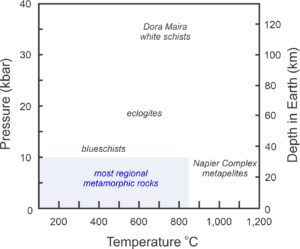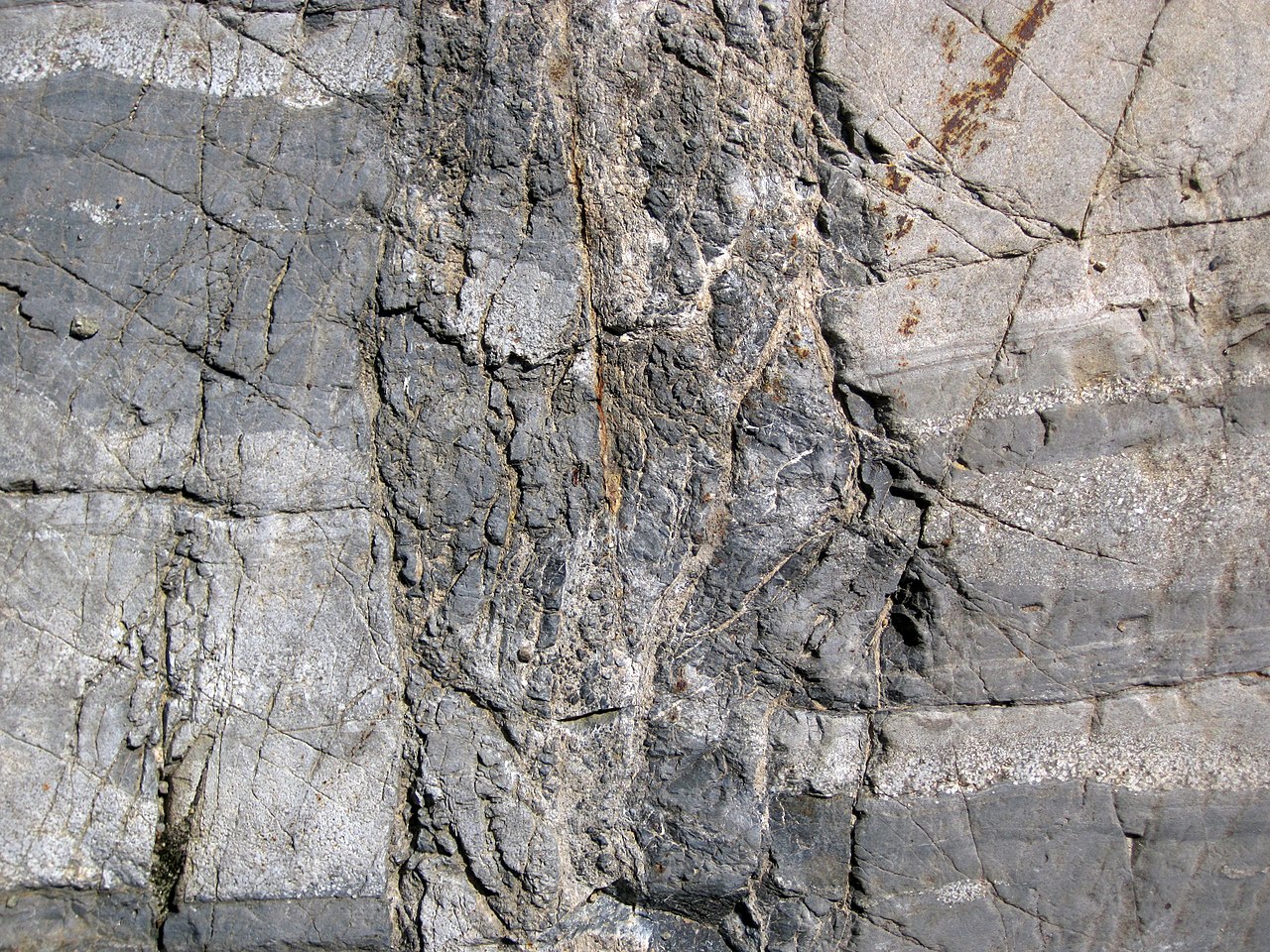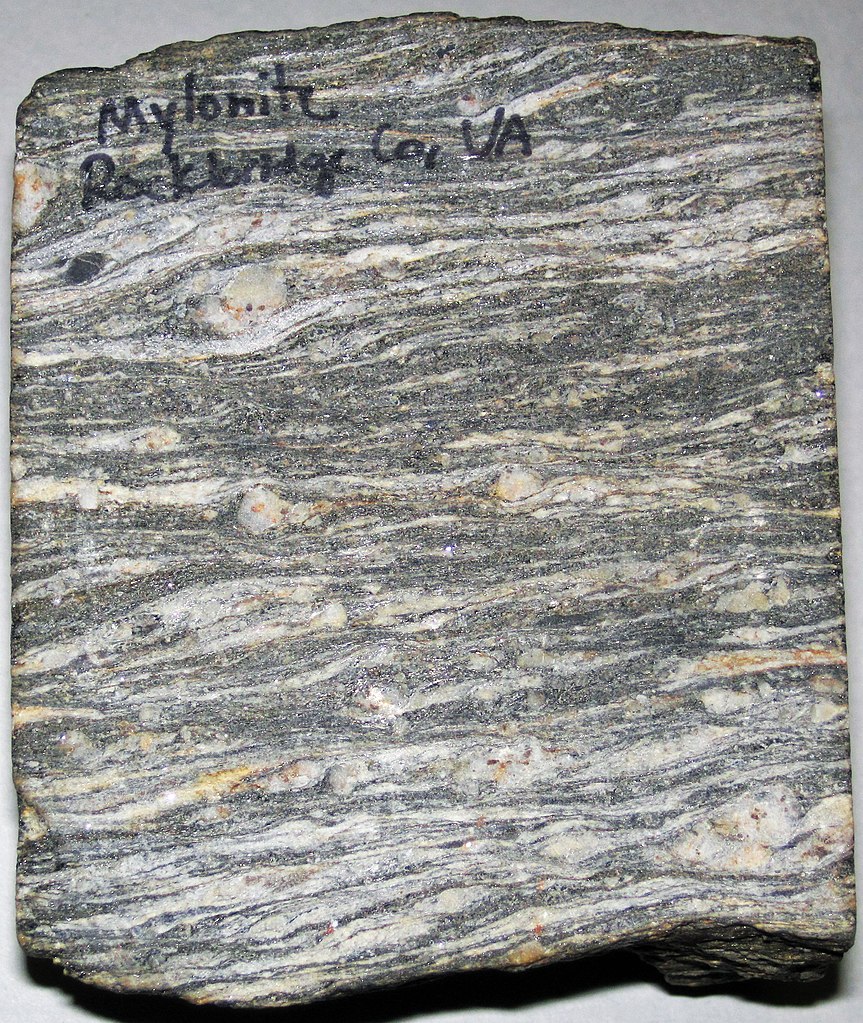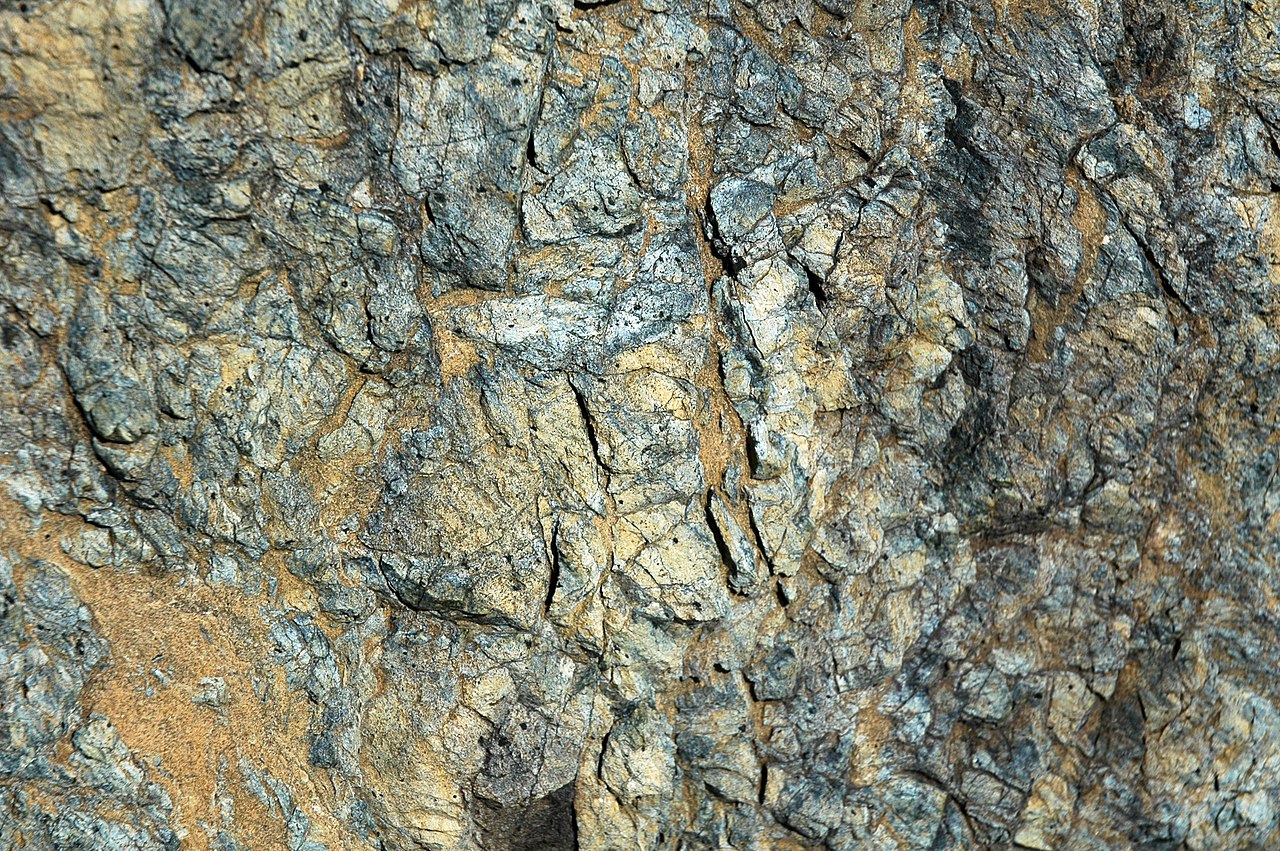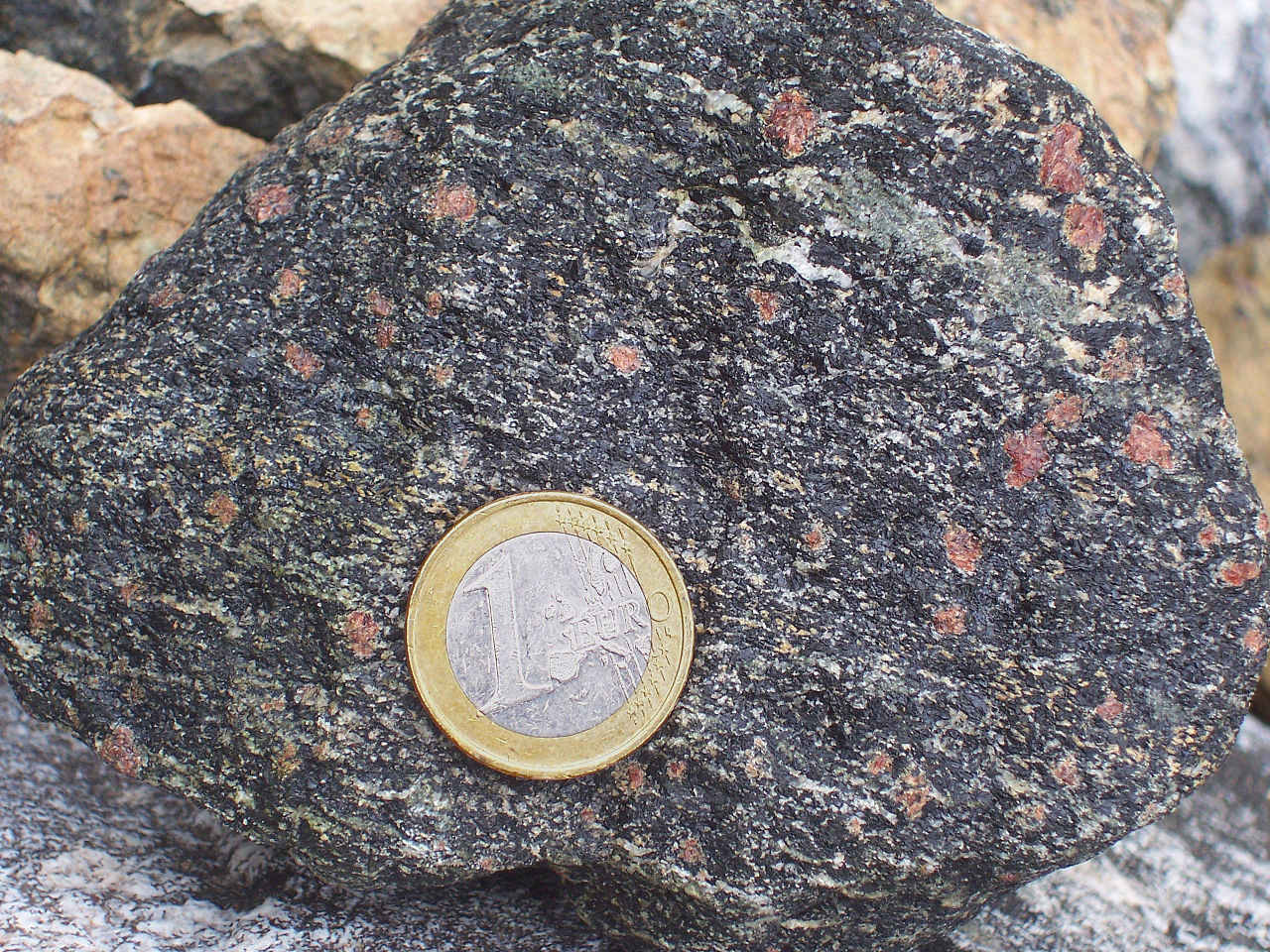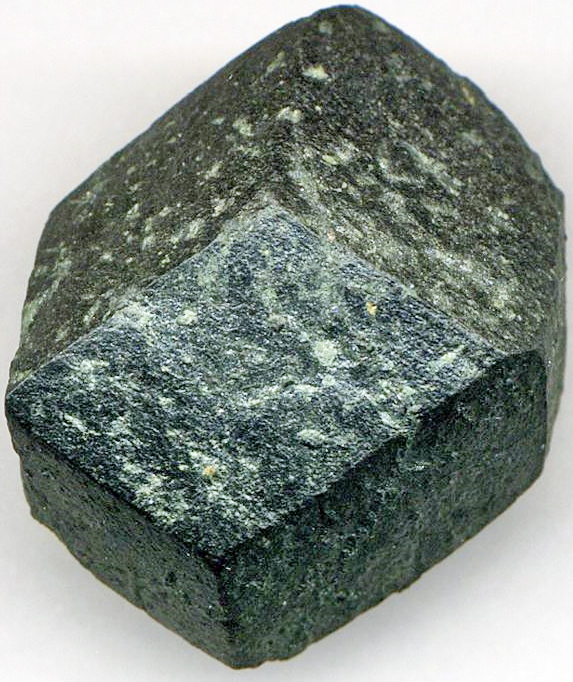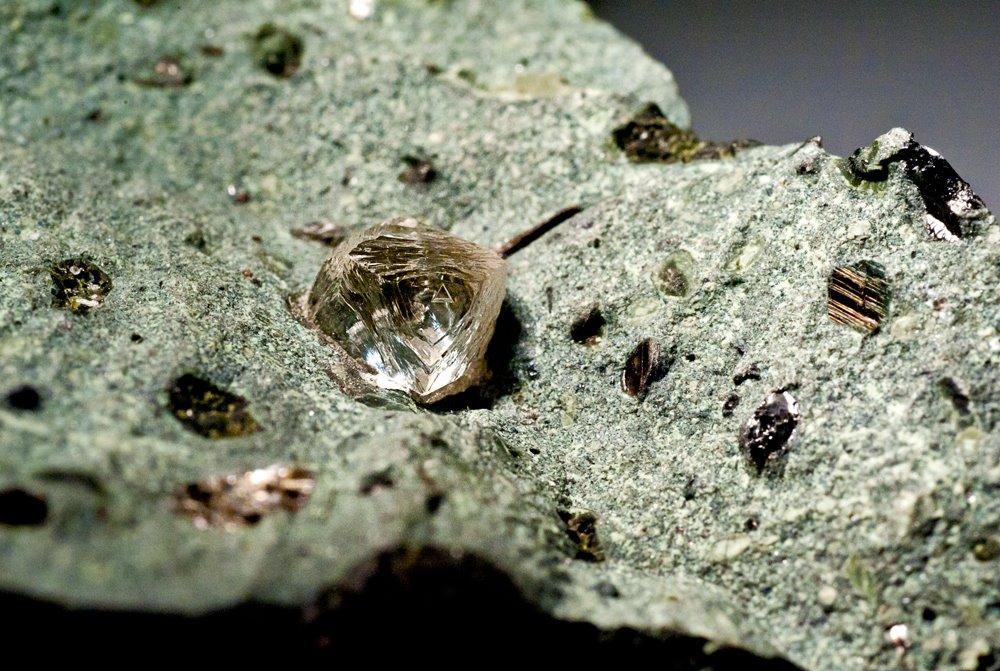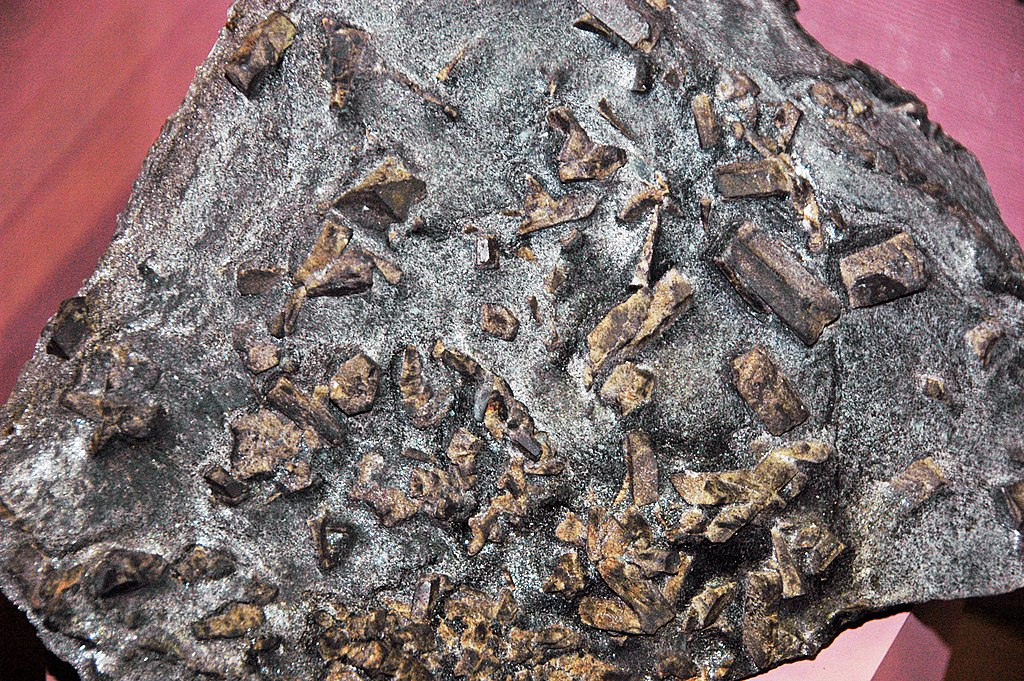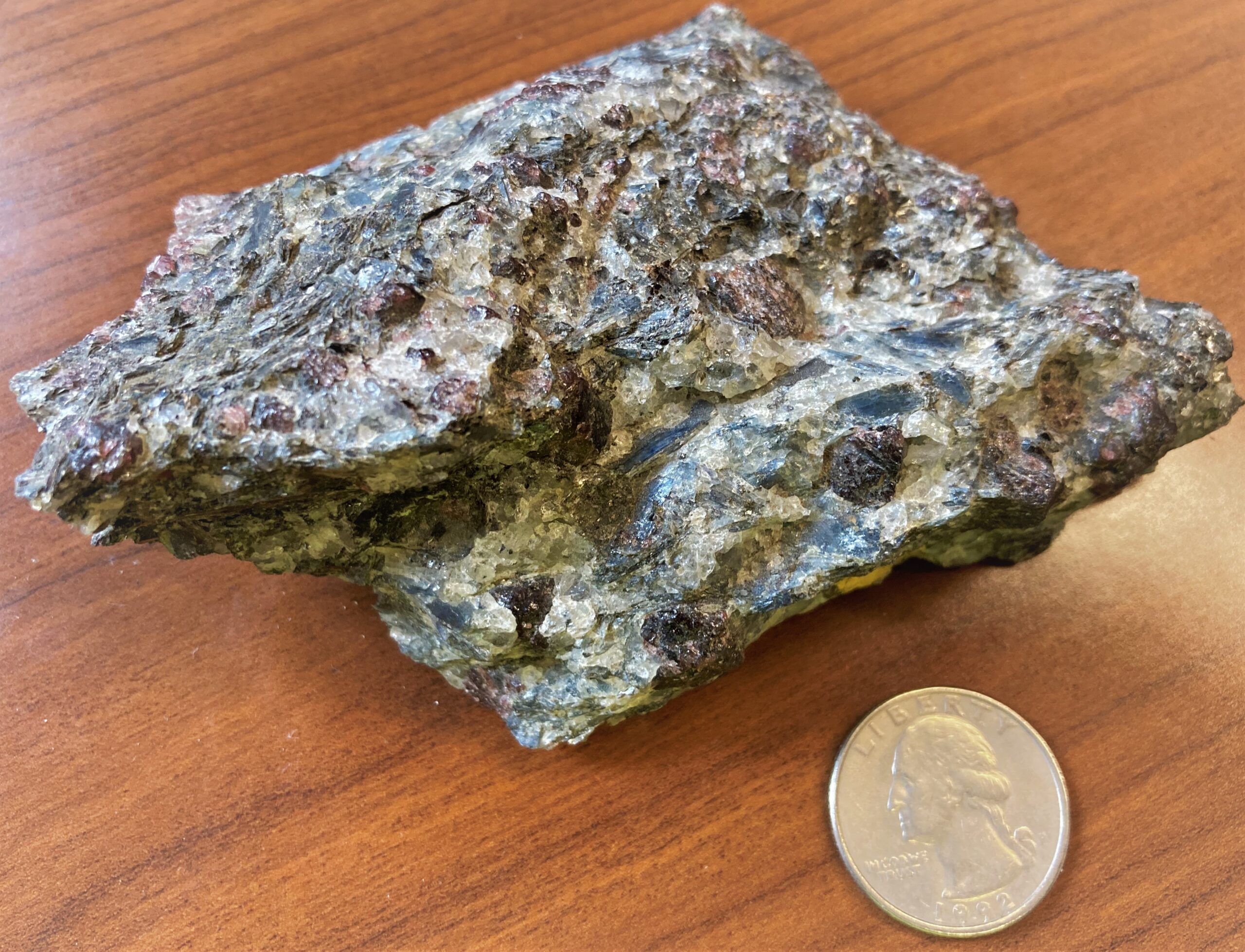
Garnet-kyanite schist from Glen Clova, Scotland
KEY CONCEPTS
- Metamorphic rocks form when heat, pressure, or chemically reactive fluids cause changes in preexisting rocks (protoliths) with no melting involved.
- Metamorphic protoliths, can be igneous, sedimentary, or metamorphic rocks of any sort.
- The composition of the protolith is most important factor determining the kinds of metamorphic rocks that form.
- Rocks are chemical systems defined by their compositions, and the systems follow the Laws of Thermodynamics.
- Metamorphism may involve changes in a rock’s texture, mineralogy, or composition.
- Metamorphic heat is transferred by a combination of conduction and convection.
- Most metamorphic rocks form at temperatures of 200-850 oC.
- At high temperatures, metamorphic rocks may undergo partial melting and thus become igneous rock. But some can be heated to temperatures greater than 900 or 1,000 oC before they begin to melt.
- Metamorphic pressure is generally due to burial and the weight of overlying rocks. Most metamorphic rocks form at pressures less than 10 kbar.
- Metamorphism often involves fluids that promote chemical reaction. Most metamorphic fluids are H2O-rich.
- Major kinds of metamorphism include burial metamorphism, regional metamorphism, contact metamorphism, dynamic metamorphism, hydrothermal metamorphism, and impact metamorphism.
- Metamorphism may occur in response to temperature increase (prograde metamorphism) or in response to temperature decrease (retrograde metamorphism).
- Rocks may follow complex pressure-temperature paths as they are metamorphosed.
9.1 What Is Metamorphism?
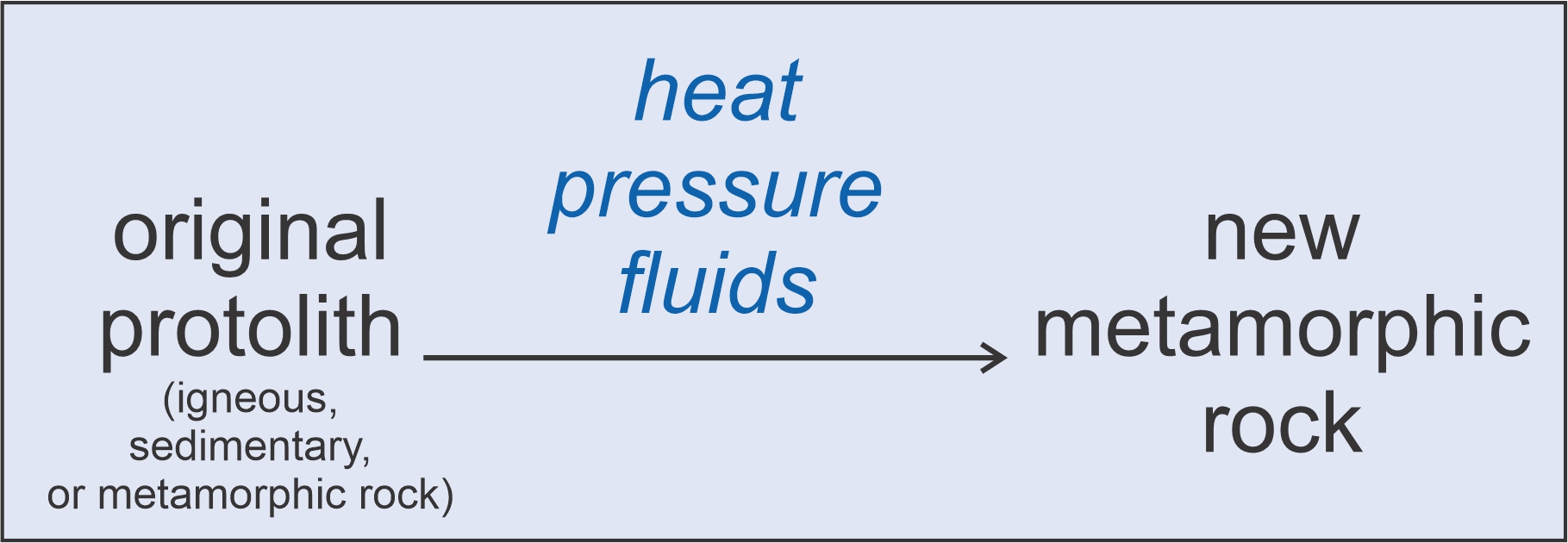
Metamorphic rocks form when heat, pressure, or chemically reactive fluids cause changes in preexisting rocks (Figure 9.1). The preexisting (parent) rocks, called protoliths, can be igneous, sedimentary, or metamorphic rocks of any sort. The changes that occur may involve changes in rock texture, in the minerals present, and in overall rock composition. So, metamorphic rocks, and the processes that create them, are key parts of the rock cycle that also includes igneous and sedimentary rocks and processes. Thus, metamorphic rocks record Earth history, and metamorphic petrologists try to interpret the rocks to interpret the history.
In Chapter 8 we introduced the Laws of Thermodynamics. In that chapter we were considering mostly melting reactions, but below the solidus, where melt is absent and metamorphism occurs, the principles of thermodynamics also apply. The fundamental principle is that chemical systems will react in ways that minimize the system’s overall chemical energy, called the Gibbs free energy (ΔG). When energy is minimized, the system is at chemical equilibrium and the phases present are the stable phases.
Rocks are chemical systems defined by their compositions, and they follow the rules of thermodynamics like any other kind of system. Thus, for any rock at some specific pressure and temperature there is only one equilibrium mineral assemblage, and for solid-solution minerals, only a single mineral composition is stable. If the pressure or temperature change, a different assemblage and different compositions may become stable, and chemical reactions may occur to regain stability. Changes in the minerals present, or changes in their compositions are kinds of chemical processes called phase changes.
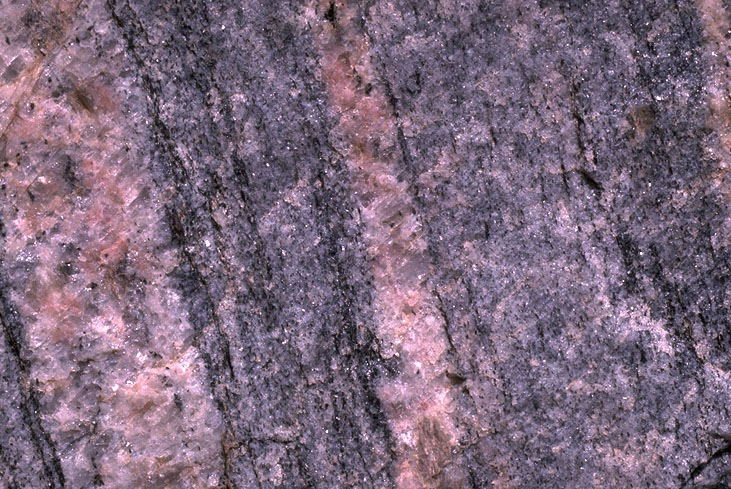
Besides phase changes, however, metamorphism commonly causes physical changes. Such changes occur to minimize physical energy – just as phase changes occur to minimize chemical energy. Rocks may develop textures, called metamorphic fabrics. Some common fabrics involve separation of minerals into layers of different compositions or alignment of mineral grains. For example, Figure 9.2 is a photo of a gneiss with a foliation (a striped or layered appearance) due to parallel layers of different compositions. And, within each layer, black biotite crystals are aligned parallel to the foliation. Other kinds of physical changes include recrystallization when many small grains combine to produce larger grains.
Overall, the changes that occur during metamorphism vary depending on rock composition and metamorphic conditions. Sometimes chemical changes dominate, and sometimes physical changes dominate. So, metamorphic rocks may be characterized by metamorphic minerals or by metamorphic fabrics, or by both.
9.2 Conditions of Metamorphism
Although metamorphic changes can occur in response to either heat, pressure, or reactive fluids, petrologists often think of temperature as most important. Part of this perspective is because heat often promotes metamorphic reactions more than pressure or fluids do. This is because adding heat to a system improves reaction kinetics. So, petrologists commonly talk about metamorphic grade, which is a relative scale of metamorphic intensity based on temperatures of metamorphism. Low-grade rocks -rocks metamorphosed at low temperature – may change only very slowly, and some changes may not go to equilibrium. High-grade rocks -rocks metamorphosed at high temperature – generally do not have the same problems. However, there are many kinds of metamorphic rocks, and some of them are more chemically reactive than others.

Low-grade metamorphic rocks typically form at temperatures between 200 and 450 °C. They mostly form at low pressures, too. Most low-grade metamorphism involves minerals in a protolith reacting with water to produce hydrous minerals such as chlorite. The photo in Figure 9.3 is an example of a low-grade mafic metamorphic rock, a gold-bearing greenschist from the Homestake Mine in South Dakota. The rock contains mostly chlorite but, if you enlarge the photo, two small flecks of native gold (Au) are visible near the center of the bottom edge. Low-grade rocks can be difficult to study due to fine grain sizes, and the minerals in them frequently do not represent chemical equilibrium. For these reasons, many metamorphic petrologists prefer to study higher-grade rocks.
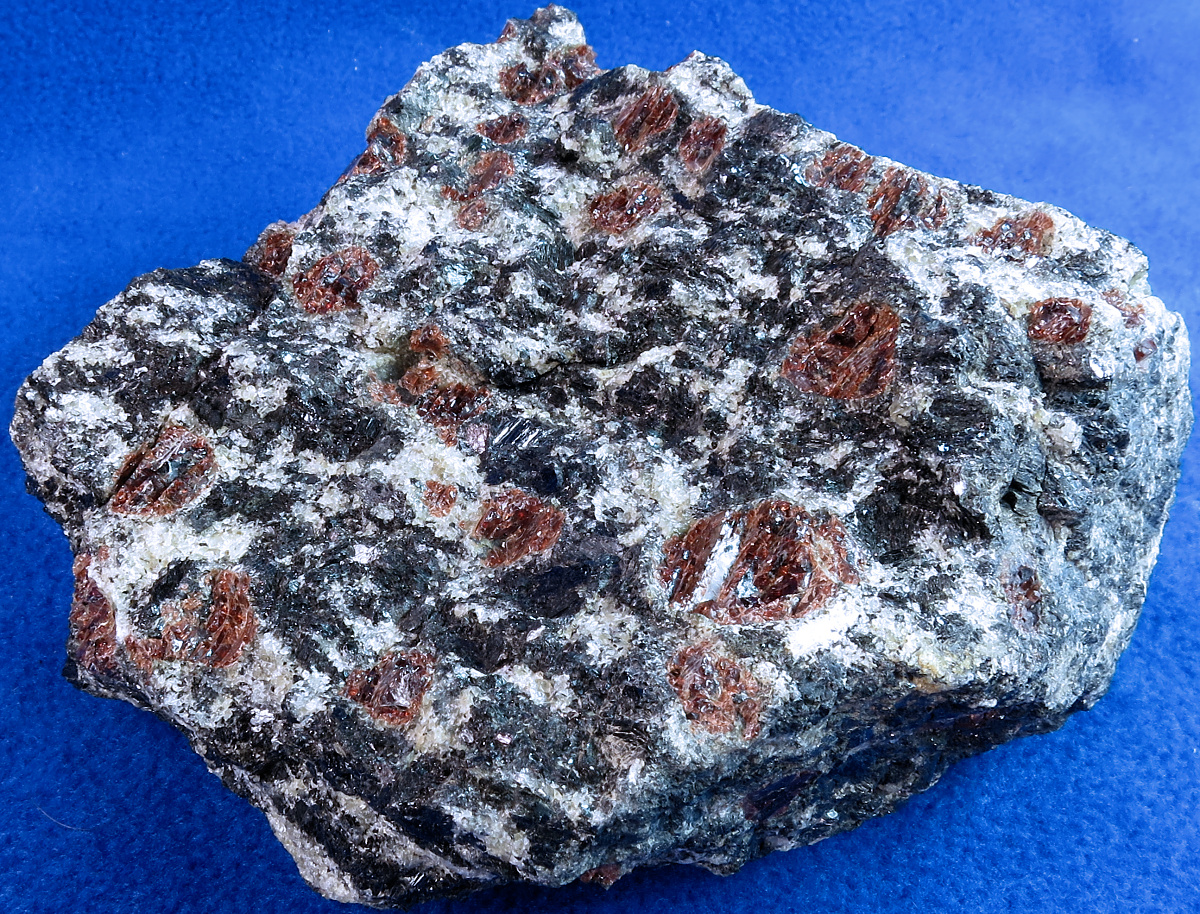
Medium-grade metamorphism, generally occurring at temperatures between 400 and about 600 oC, often produces rocks containing metamorphic minerals we can easily see and identify. Many schists are medium-grade rocks.
High-grade metamorphic rocks, which normally form at temperatures greater than about 600 °C, are usually quite coarse-grained and contain minerals easily identified in hand specimens. Most form at high pressures. Many high-grade rocks develop gneissic textures, like the texture seen in Figure 9.1. Others, like the high-grade garnet granulite in Figure 9.4, lack foliation. This granulite contains conspicuous centimeter-sized red garnet, black hornblende, and white plagioclase feldspar.
Metamorphism occurs over a wide range of pressure and temperature. Most rocks will begin to show metamorphic changes when heated to 150-200 oC, and some can be heated to temperatures greater than 900 or 1,000 oC before they begin to melt and enter the realm of igneous rocks. Some metamorphic rocks form at Earth’s surface, at 1 atm, but others come from deep in Earth where pressure is greater. During regional metamorphism, high temperatures and thus high-grade rocks, are associated with high pressures. During contact, or other kinds of metamorphism, this may not be the case.
9.3 The Distinctions Between Sedimentary, Metamorphic, and Igneous Processes
When exposed at the surface, rocks that originally formed at higher temperature and pressure may be unstable at Earth-surface conditions. Often, they weather to produce clays, zeolites, or other minerals that are more stable. And after a sedimentary rock forms, diagenetic reactions may take place that produce new minerals. These events (weathering and diagenesis) are, in a sense, kinds of metamorphism. But weathering and diagenesis are considered low-temperature sedimentary processes. Petrologists reserve the term metamorphism for changes that occur between conditions of weathering/diagenesis and melting.
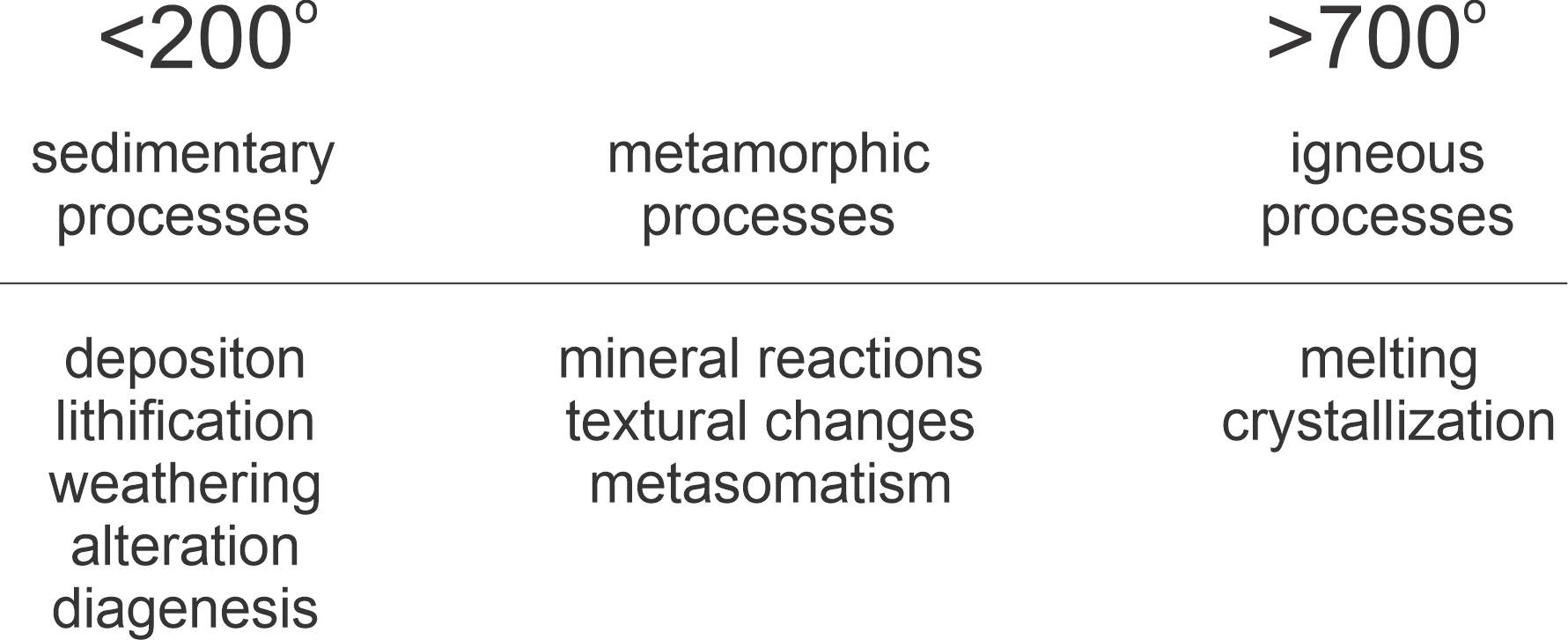
The temperature boundary between sedimentary processes and metamorphic processes occurs, perhaps, at 200 – 300 oC, but is blurred because the two kinds of processes form a continuum (Figure 9.6). Adding more complications – many minerals created by alteration or diagenesis also form during low-temperature metamorphism. Sometimes we identify metamorphic rocks by their fabrics, but metamorphic fabrics develop slowly and incipiently at low temperatures and may be difficult to distinguish from sedimentary textures.
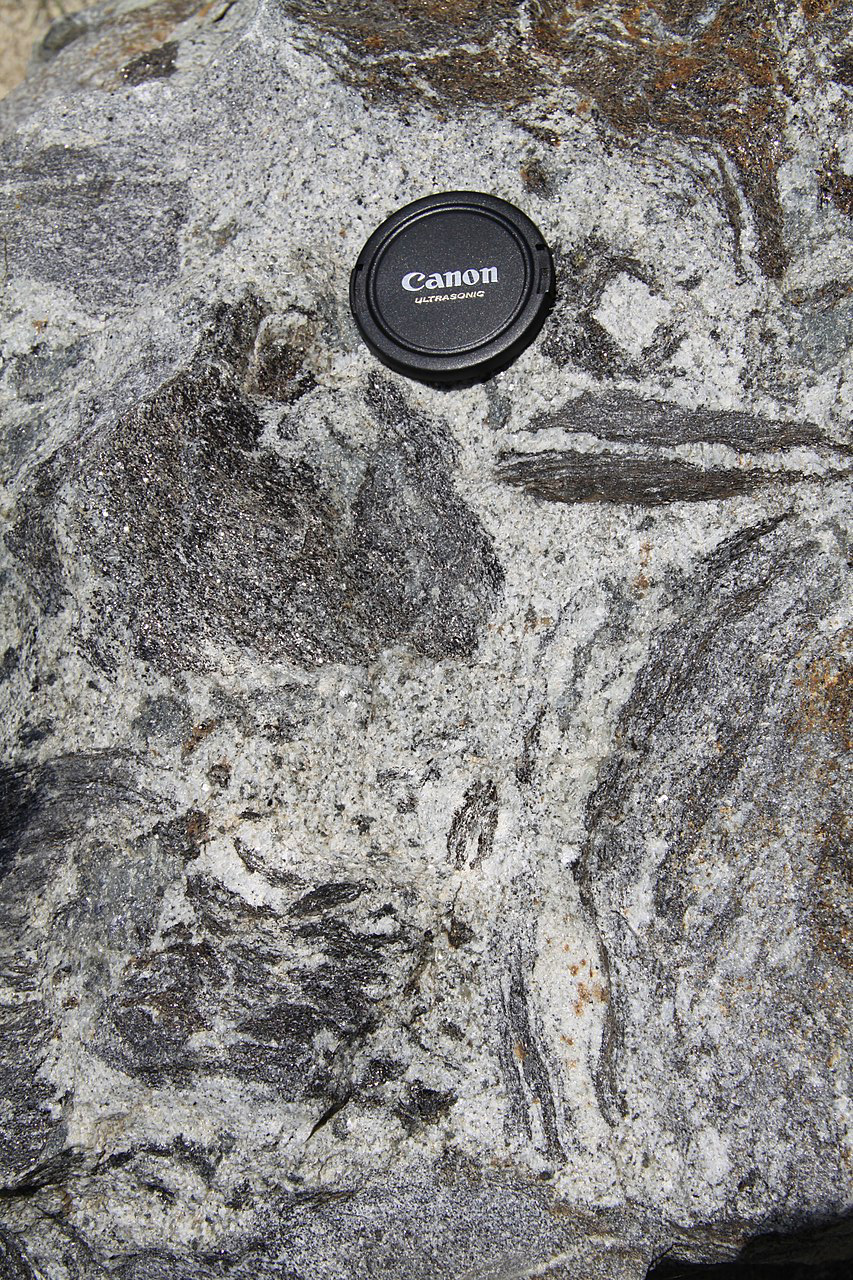
At high temperatures, the boundary between metamorphic and igneous processes can also be blurry. Depending on its composition, with more heating, a high-grade metamorphic rock may undergo partial melting, also called anatexis, so both metamorphic and igneous processes contribute to its evolution. When this happens, the rock becomes a kind of rock that, strictly speaking, is no longer a metamorphic rock. However, some rocks melt below 700 oC, and others do not melt until temperatures are much greater, perhaps 1,100 oC. So the upper temperature of metamorphism varies with rock composition. Some high-temperature rocks, called migmatites, develop textures that appear to be part way between metamorphism and melting. Figure 9.7 shows an example. The name migmatite comes a Greek word for mixed rock.
9.4 Agents of Metamorphism
9.4.1 Heat and Temperature

Heat is thermal energy that can move (flow) from one place to another or from one substance – such as rock, magma, or water – to another. Thermal energy is high for substances at high temperature and low for substances at low temperature, and heat natural flows from high-temperature to low-temperature materials. Three processes can transfer heat: conduction, convection, and radiation; but within Earth, heat transfer by radiation is insignificant (Figure 9.8).
Conductive heat transfer occurs when heat flows naturally through solid material from a place of high temperature to one of low temperature with no associated movement of matter. Thus, for example, heat is always flowing from Earth’s hot interior to the cooler surface by conduction. And if a (hot) magma intrudes the (cooler) crust, the magma will cool as heat is conducted grain-by-grain into the surrounding rock, causing the rock to warm. This warming initially occurs only next to the pluton, but, over time, heat is conducted farther away and warming can affect a large area.
Convective heat transfer is the transfer of heat due to the flow of material, such as the flow of water, of hot magma and, occasionally rock. It is more efficient than conductive heat transfer. Within Earth, convection occurs mostly because of flowing magmas or flowing asthenosphere that moves like a very viscous liquid. Heat carried by convecting magmas can be much more significant than conducted heat alone, and can warm huge regions of the crust. And in Earth’s mantle, the slow creep of solid rock due to plate tectonics also moves heat by convection. Heat transfer by water can have a significant, although generally quite local, effect near Earth’s surface.

Heat flows naturally from Earth’s interior toward the surface, but different places get their heat flow by different combinations of conduction and convection. Earth’s geothermal gradient, also called its geotherm, is the rate at which temperature increases with depth. It averages about 25 to 35 oC/km near the surface in most places (black line in Figure 9.9). This normal gradient is due solely to conductive heat flow. In some places, however, rising rock or magma provide additional heat. For example, at mid-ocean ridges, rising mantle and magma mean that temperature increases rapidly with depth compared to average (red line in Figure 9.9). In mountain belts and other places where volcanic activity occurs, convective heat flow due to rising magmas contributes much more heat than normal conduction. Consequently, temperature increases faster with depth than is normal (orange line in Figure 9.9). In some places, next to large igneous intrusions, contact metamorphism occurs and extremely high temperatures may persist for short times before the intrusions cool. In subduction zones, the opposite occurs. Descending slabs of cool oceanic lithosphere cool the crust and upper mantle below, causing a decrease in heat flow. So, the rate of temperature increase with depth is less than normal (blue line in Figure 9.9).
9.4.2 Pressure and Depth
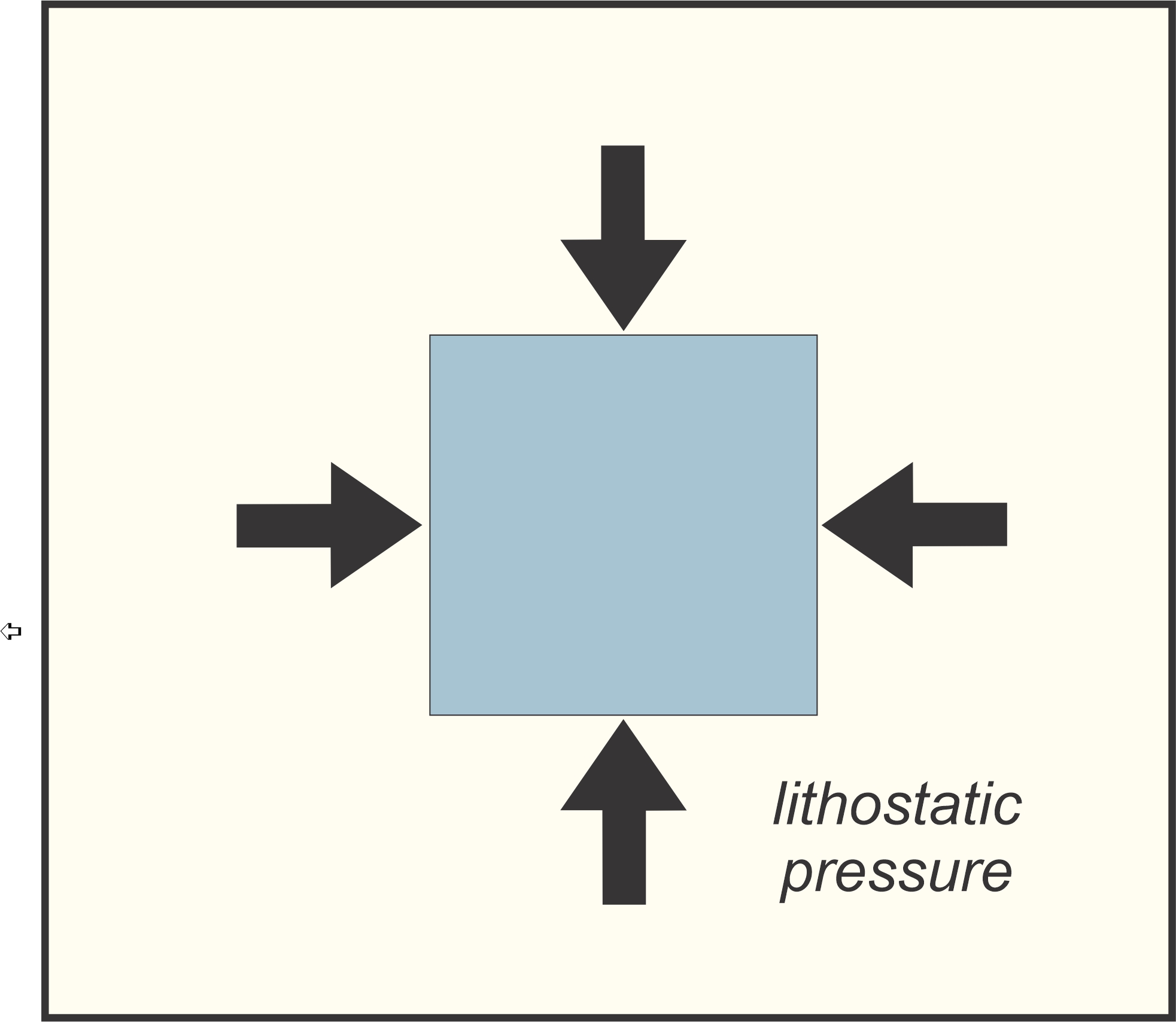
Burial causes rocks to experience lithostatic pressure, also called confining pressure. Lithostatic pressure is the same in all directions, and thus can cause an object to become smaller without altering its overall shape (Figure 9.10). This kind of pressure is equivalent to the pressure that swimmers feel on their ears when they go to the bottom of the deep end of a swimming pool. The pressure on a swimmer’s ears accrues because of the weight of water pushing down from above. Within Earth, the weight of rock, which is commonly three times denser than water, causes lithostatic pressure to increase quickly with depth. As seen in Figure 9.9, pressures reach around 12 kbar at 40 km depth.
Typical metamorphic rocks form at pressures less than 10 kbar, but as noted earlier in this chapter, we find higher-pressure rocks in some places. They are rare because to be metamorphosed at very high pressure requires that rocks are at great depth. Subsequently, getting the rocks back to the surface so we can see them is very problematic.
9.4.3 Directed Stress
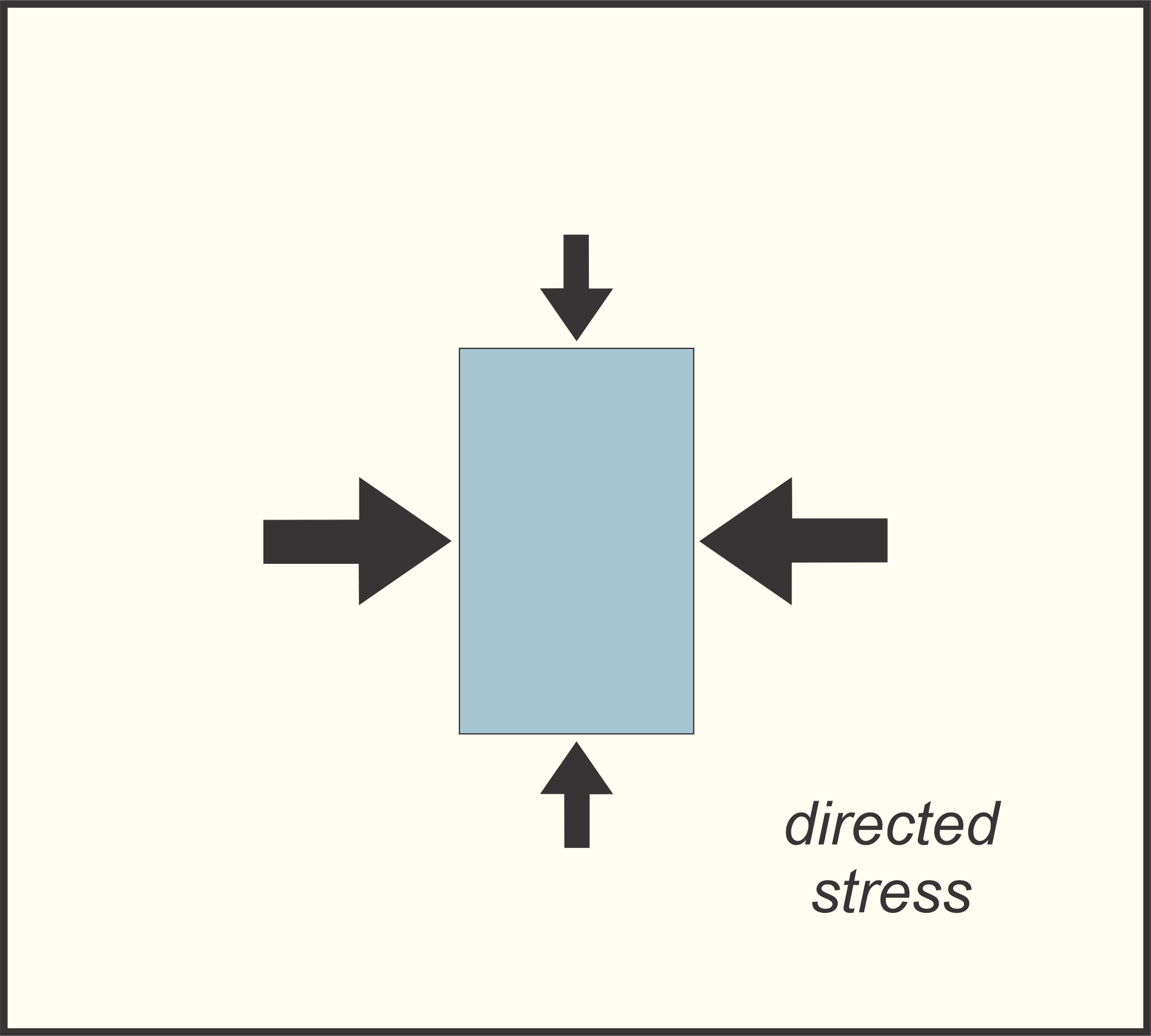
Directed stress, sometimes called differential pressure, is a force that is not the same in all directions, applied to a volume of material (Figure 9.11). For example, when we squeeze a lemon, we are applying directed stress. When we stretch a rubber band, we are also applying directed stress. Within Earth, directed stress is common due to plate tectonic processes that push large pieces of lithosphere together or pull them apart. However, rocks cannot sustain high levels of directed stress for long because rocks deform to reduce the stress. Directed stress, thus, is commonly associated with places where rock folding, faulting, or other deformation is actively occurring.
Directed stress can cause new minerals to form within a rock, but much more commonly it produces metamorphism involving deformation, fracturing, or textural changes only. Mineral grains may rotate, align, become distorted, or disintegrate. Directed stress may also cause recrystallization as grains dissolve and regrow in other places, or combine to produce larger crystals.

Sometimes, directed stress causes shearing, which means that different parts of a rock slide past each other. During shearing mineral grains can become stretched in one direction, and fractures can develop, giving a rock a foliated texture. Figure 9.12 shows an example of a sheared rock – a mylonite from Norway’s Western Gneiss Region that contains recrystallized sheared material. Directed stress, parallel to the layering in this rock, caused feldspar (white) and biotite (black) grains to become elongated as shearing took place. While this was occurring, metamorphism produced wine-red garnet crystals – a single large one is near the left side of the photo, and many small garnets are also present. The 1 euro coin is 2.3 cm across, for scale.
9.4.4 Metamorphic Fluids
Metamorphism often involves fluids, which may be liquids or gases. But most metamorphism occurs at conditions above the critical point where liquids and gases are indistinguishable. The most common metamorphic fluids are H2O-rich, but sometimes CO2, sulfur, or other components are present in small or large amounts. Fluids are important because they may promote metamorphic reactions. They also act as fluxes that lead to large crystal growth.
Fluids involved in metamorphism may be magmatic (expelled by magmas as they crystallize) or meteoric (derived from precipitation that infiltrates the ground). They may also be released during subduction of wet lithosphere, or they may be products of reactions that release H2O or CO2 from minerals. During metamorphism, these fluids occupy small spaces between mineral grains.

Most fluids escape after metamorphism ceases. Sometimes, however, we can look at metamorphic fluid samples because mineral crystals may trap small droplets of the fluids present at the time of metamorphism. Figure 9.13 is a photo showing examples of fluid inclusions in quartz.
9.5 Different Kinds of Metamorphism
There is some debate about how best to classify different kinds of metamorphism, but at a fundamental level, most petrologists distinguish five or six main types. We will discuss most of these in more detail later in this and subsequent chapters. For now, we will give brief introductions. All these kinds of metamorphism result from some combination of pressure, heat, shear stress, and chemical reactions involving water or other metamorphic fluids. Because regional and contact metamorphism account for most metamorphic rocks, they are the focus of most of the rest of this book.
9.5.1 Burial Metamorphism
Burial metamorphism is the lowest-energy kind of metamorphism. It is the precursor to regional metamorphism and occurs when rocks undergoing diagenesis are buried to significant depth. Eventually, as the weight of overlying sediments increases, and temperatures increase due to burial, diagenetic processes give way to metamorphic processes. This change happens most commonly in sedimentary basins where thick layers of sediment accumulate. The transition between diagenesis and burial metamorphism occurs at temperatures of 200 to 300 oC and depths of several kilometers, but the processes overlap. During burial metamorphism, heat and pressure cause minerals to recrystallize, clay minerals to turn into different clay minerals, and new minerals – most typically zeolites – grow. Sandstone may become quartzite, and shale may become slate but, commonly, some bedding and other sedimentary structures persist and rocks may show very little outward signs of metamorphism. Burial metamorphism rarely leads to any significant development of metamorphic fabric because pressure is generally lithostatic (the same in all directions) at the shallow depths where burial metamorphism occurs.
9.5.2 Regional Metamorphism
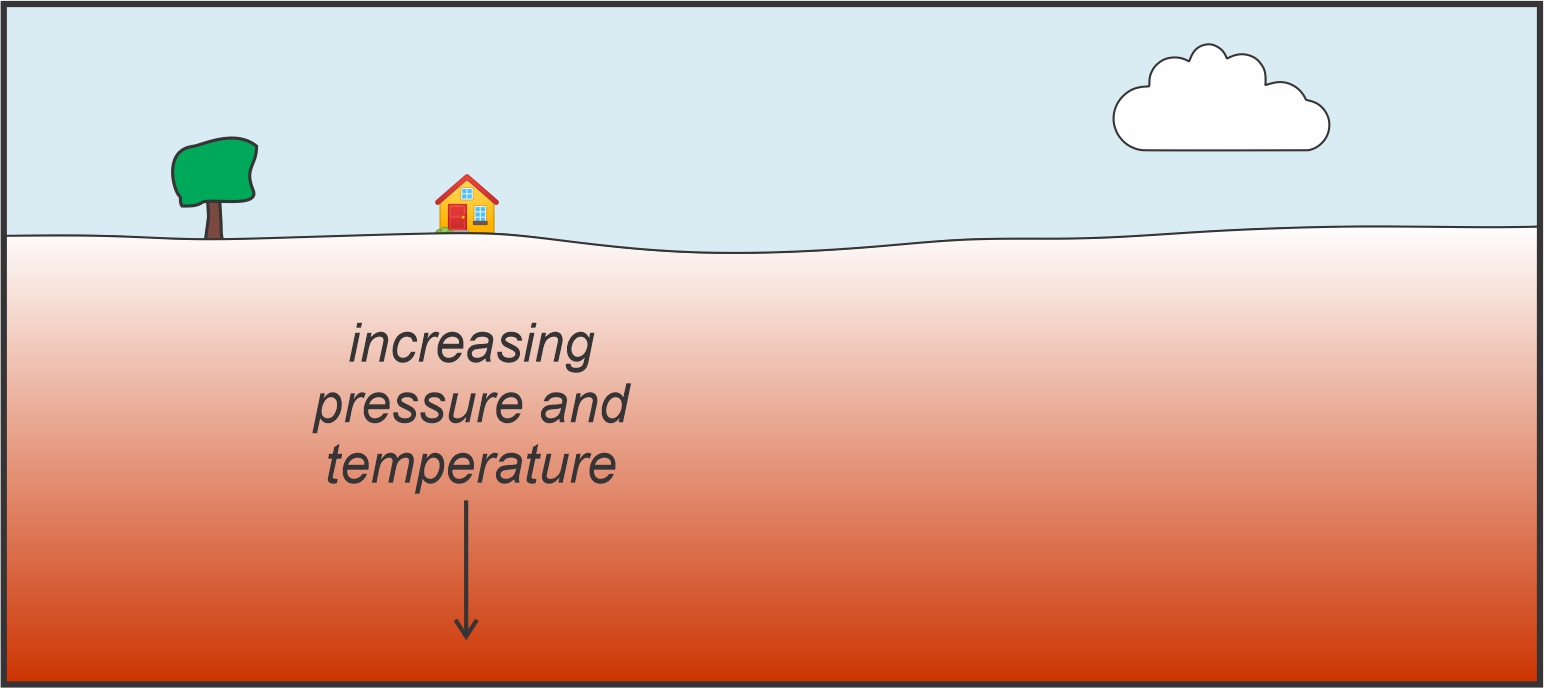
Burial metamorphism grades into regional metamorphism as temperature and pressure increase. Regional metamorphism, which occurs over millions of years, is not generally due to overlying layers of sediment being deposited and compressing rocks below. It is caused by burial and heating associated with mountain building events (orogenies). This kind of metamorphism occurs because both pressure and temperature increase with depth in Earth. The deeper the rocks, the greater the temperature, pressure, and grade of metamorphism (Figure 9.14).
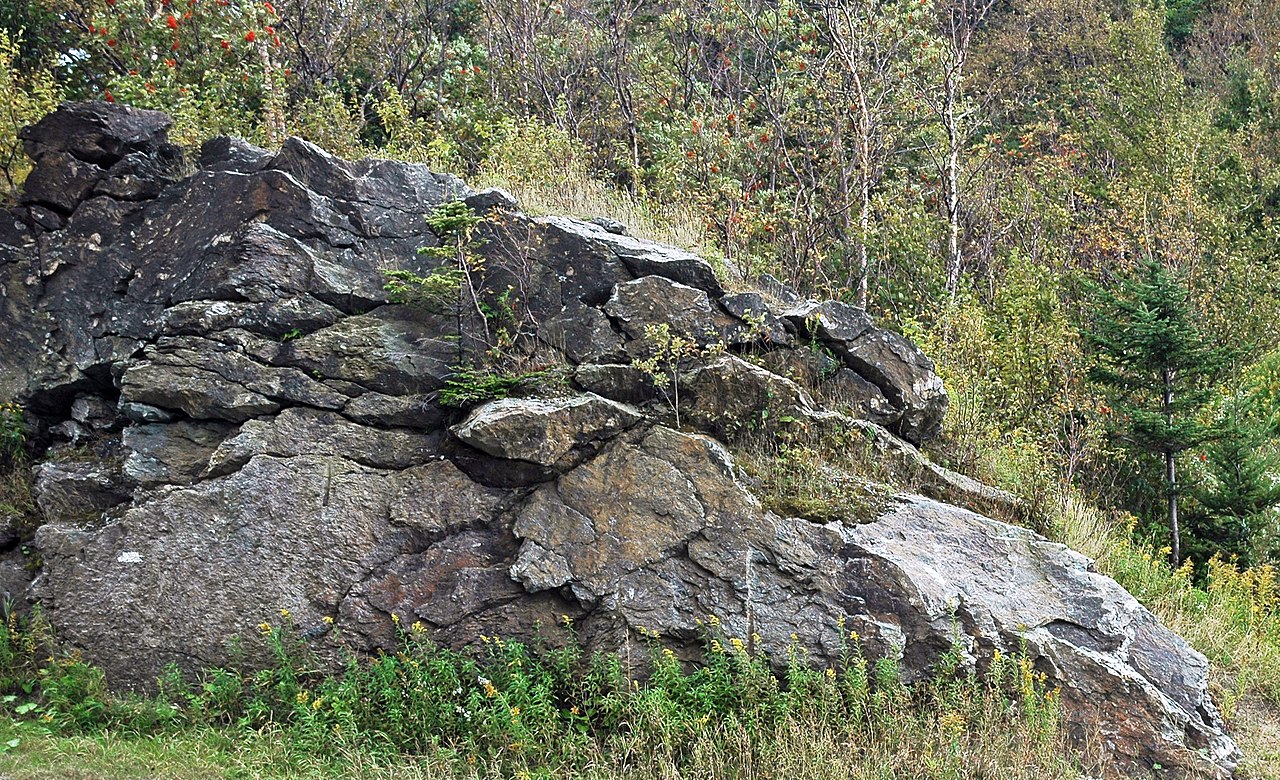
Regional metamorphism is associated with continental collisions and subduction zones. It can affect very large areas and typically creates large metamorphic terranes, regions characterized by distinctive metamorphic rocks. After tectonism ceases, uplift and erosion may expose rocks from different depths. Thus, many examples of regional metamorphism are found in mountain belts, for example the outcrop of schist in Vermont’s Green Mountains seen in Figure 9.15. Generally, the greatest uplift occurs near the centers of orogenic belts. Consequently, we typically find high pressure-temperature (P-T) metamorphic rocks in the centers of mountain ranges, with lower P-T rocks near the range margins.
However, we also find vast areas of regionally metamorphosed rocks in places that are not mountain ranges today. During orogenies, when the crust thickens, it naturally moves upward due to buoyancy, creating topographic highs (mountains). Eventually, given enough time, the mountains completely erode, thus uncovering underlying igneous and metamorphic rocks that were once at great depth. Because, upward movement and erosion are not the same everywhere in an orogenic belt, rocks coming from different depths become exposed, most significantly in regions called shields.
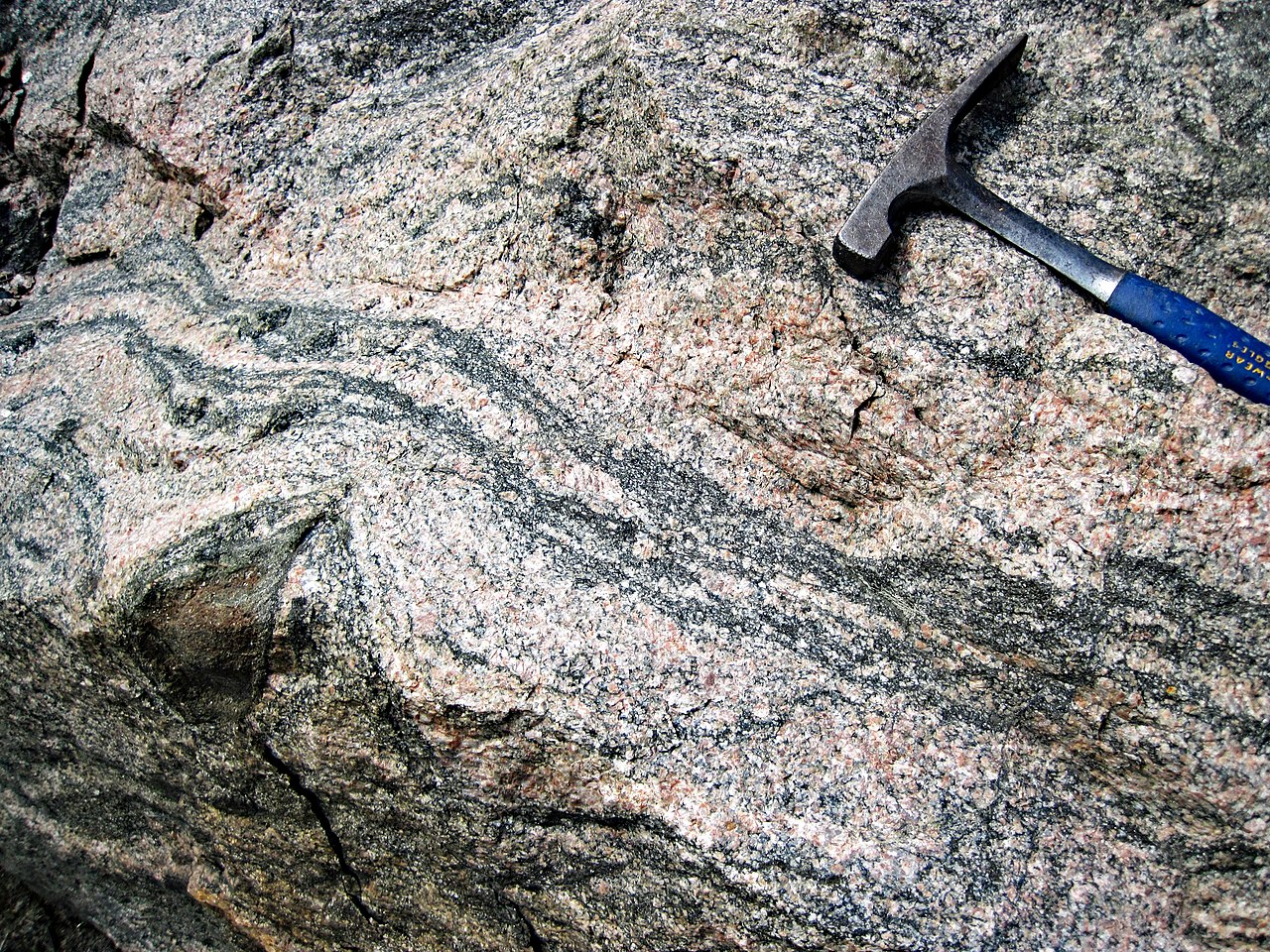
All of the world’s continents contain Precambrian shields, areas where erosion has completely removed once present mountains. Exposed shield rocks may once have been part of mountain roots 10s of kilometers beneath the surface. The gneiss in Figure 9.16 is an example. It is a high-grade metamorphic rock from the Canadian Shield in central Ontario, north of Lake Huron. The degree of metamorphism and lateral variations in metamorphism that typify shield areas tell us about the size and formation of mountains that are no longer present. Additionally, Precambrian shields are particularly important because they host many important mineral deposits.
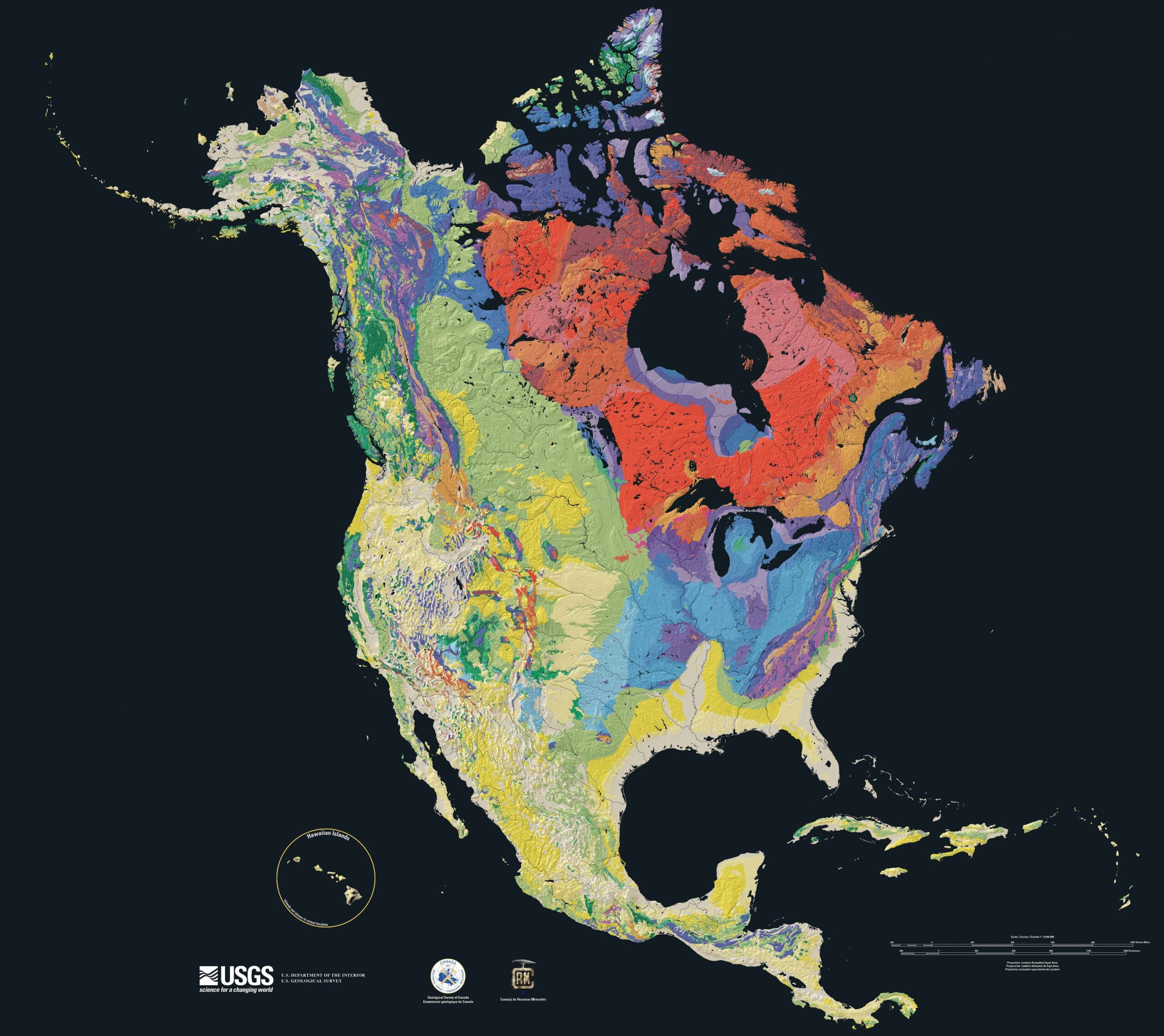
Orange and red colors in Figure 9.17, which circle Hudson Bay, show the extent of North America’s Canadian Shield. The Shield, a large generally flat area, contains most of the metamorphic rock outcrops in North America, as well as many different kinds of igneous and sedimentary rocks. The darker red colors show regions where rocks that are more than 3 billion years old can be found. Adjacent lighter orange colors show regions of 1-billion-year-old rocks. Green, blue, and purple colors, mostly within the United States, are areas where surface rocks are of Phanerozoic age (younger than 541 million years ago). This pattern – ancient Precambrian metamorphic and igneous rocks flanked by much younger sedimentary rocks – is present on every continent.
9.5.3 Contact Metamorphism
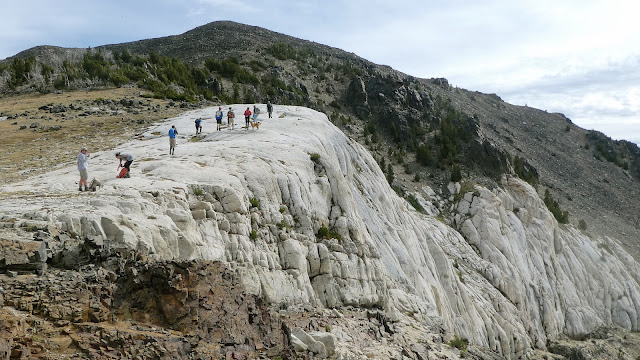
Although regional metamorphism, which accounts for most metamorphism, occurs at moderate to deep levels within Earth, metamorphism can also occur at shallow levels or even at Earth’s surface. Sometimes magma that intrudes the crust may rise close to, or all the way to, the surface. In such cases, heat from the intrusion can cause contact metamorphism that affects shallow or surficial surrounding rocks, which we call country rocks. The effects of such metamorphism may be profound because of the high temperature contrast between magma temperatures and country rock temperatures. Contact metamorphism of limestone, for example, can produce white marble, such as the marble seen in Figure 9.18.
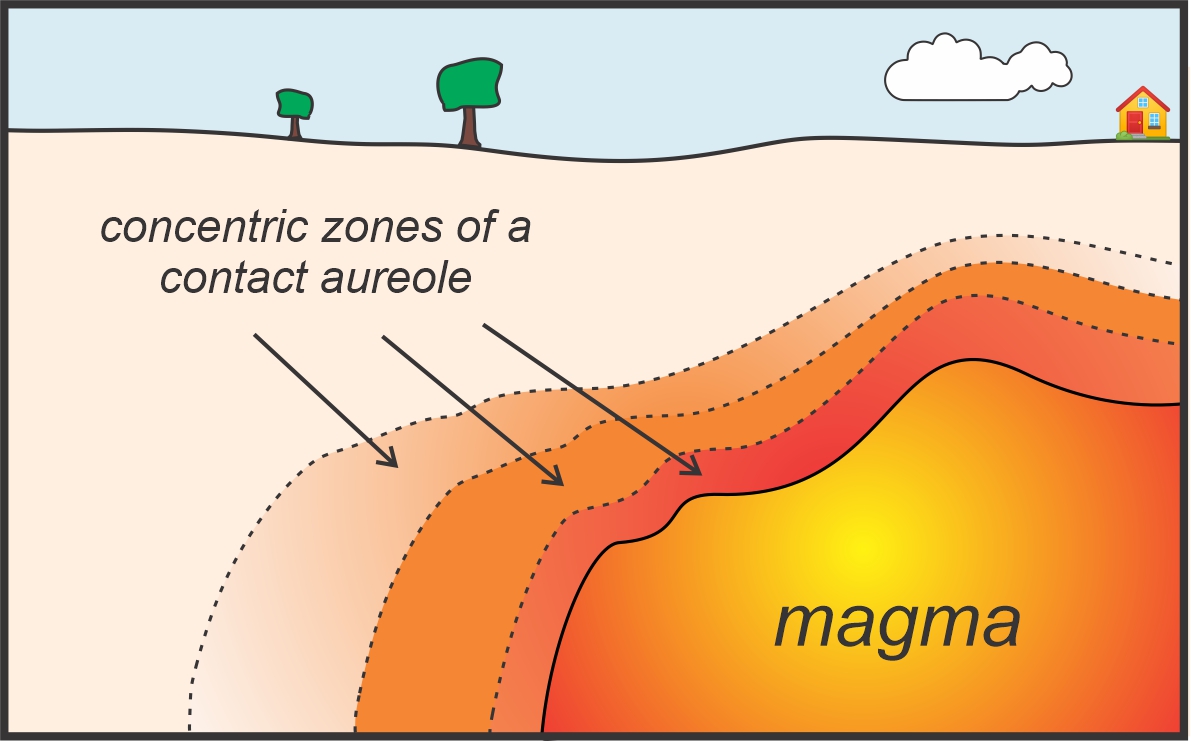
Contact metamorphism typically leads to the development of metamorphic zones parallel to the contact between the intrusion and the country rock. These zones comprise a contact aureole (Figure 9.19). Sometimes aureoles wrap around a pluton and consist of concentric zones that contain different mineral assemblages. The number of zones that form, and the minerals they contain, depend on several things, including the composition of the country rock. Additionally, the size and temperature of the intruding igneous rock has a profound effect. If metamorphism is caused by intrusion of a thin dike or sill, the surrounding aureole may be quite thin. If it is caused by a large intrusion, the aureole will be thicker because it takes longer for large intrusions to cool, and more country rock will be heated. Although much larger ones are known, most contact aureoles have thicknesses between a few centimeters and a few 10s of meters.
The formation of a contact aureole frequently involves metasomatism, a change in country rock composition due to flowing metamorphic fluids that add or remove elemental components. Minerals in the different zones of an aureole, and zone thicknesses, not only reflect the composition of the country rock and the metamorphic temperature, but also the amount of metasomatism that occurs. Metasomatism can be especially significant when the country rock is a carbonate (limestone or dolostone), because a large number of different metamorphic minerals may develop that would not be found in carbonate rocks otherwise. We will see some spectacular examples when we look at skarns, later in Chapter 15 (Section 15.8.3). Figure 9.26, later in this chapter, shows one example.
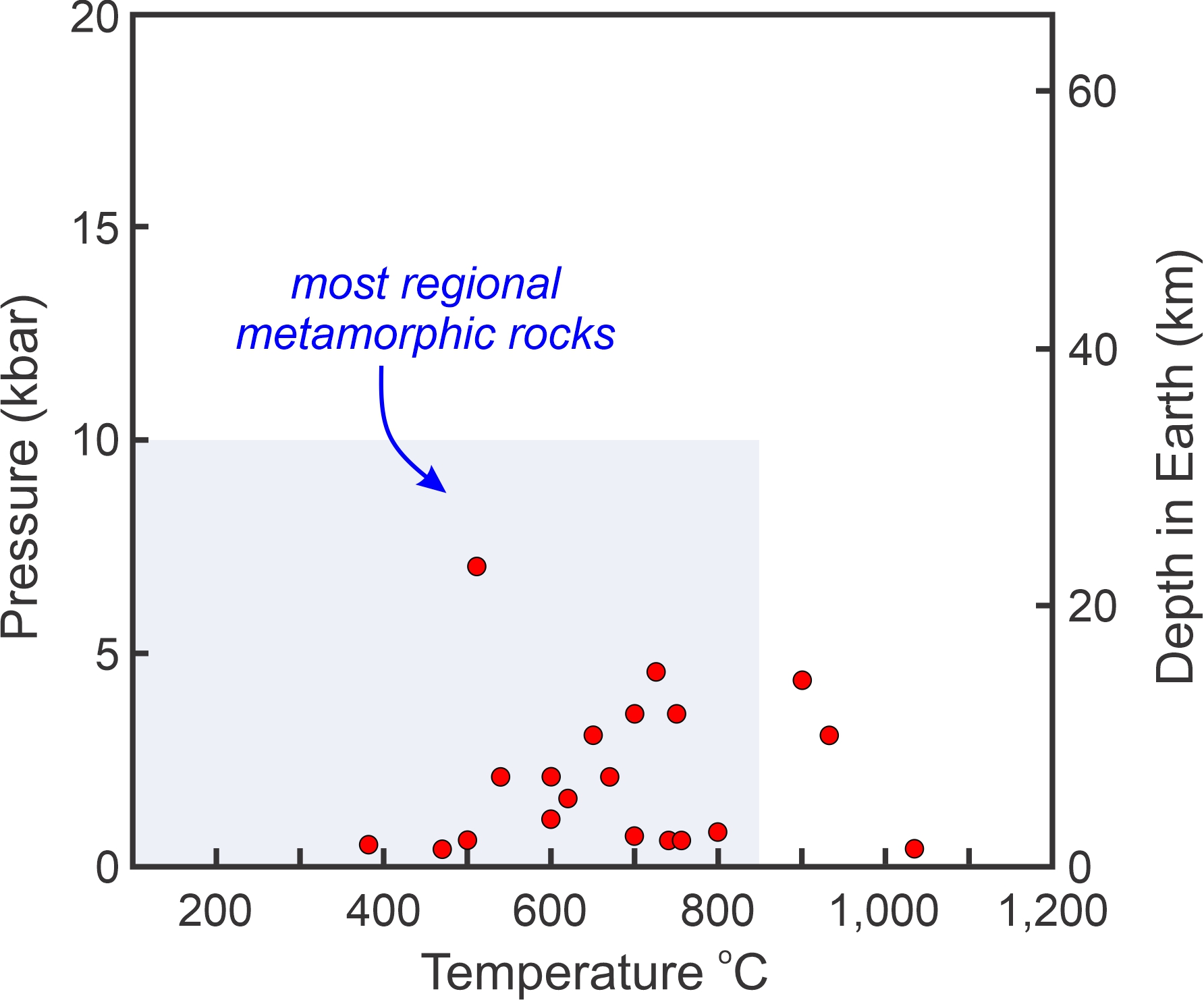
Magmas that intrude the crust generally are at temperatures of 900 oC or greater – most greater than 1,000 oC. But, they intrude slowly and cool relatively quickly. Rocks closest to the contact between the intrusion and the country rock will be heated to the highest temperature. In most cases, this maximum temperature is the average of the intrusion temperature and the country rock temperature. Red dots in Figure 9.20 depict peak metamorphic conditions for a number of different contact aureoles, plotted on top of the P-T field for most metamorphic rocks (blue) that we saw in Figure 9.5. Typically, the highest-grade rocks in a contact aureole equilibrated at temperatures of 500 to 800 oC and pressures of 4 kbar or less. There are, however, exceptions. Additionally, contact metamorphism that occurs at significant depth in Earth may be indistinguishable from regional metamorphism.
9.5.4 Dynamic Metamorphism
High shear stresses associated with fault zones can cause dynamic metamorphism (also called fault-zone metamorphism). This kind of metamorphism involves a localized low-temperature process that produces physical, but often no mineralogical changes. Unlike other kinds of metamorphism, metamorphic temperatures may not exceed 100-200 oC.
|
|
|
Products of dynamic metamorphism, called cataclastic rocks, include ground-up and deformed rocks such as those seen in the fault zone above the knapsack in Figure 9.21. Dynamic metamorphism also sometimes produces fault breccia made of broken up rock fragments (Figure 9.22), or mylonites made of long stretched out mineral crystals (Figures 9.23). The effects of directed stress on the rock in Figure 9.23 are profound. We saw a somewhat similar rock earlier in this chapter in Figure 9.12.
9.5.5 Hydrothermal Metamorphism
|
|
|
Some metamorphism occurs when water flows through a rock without significant changes in temperature or pressure. This kind of metamorphism, hydrothermal metamorphism often produces low-temperature alteration of country rocks. For example, Figure 9.24 is a photo of a serpentinite from near the Golden Gate Bridge in San Francisco, and Figure 9.25 shows an altered outcrop of serpentinite. Serpentinites form by low-temperature hydrothermal metamorphism of ultramafic rocks.
At higher temperatures, hydrothermal metamorphism may affect large areas and be part of regional metamorphism, or it can be localized and part of contact metamorphism. In either case, the metamorphism involves hot, generally water-rich fluids that flow through cracks and along grain boundaries. The fluids act as catalysts and fluxes that promote reactions and sometimes large crystal growth. More important, the fluids may cause metasomatism that changes the composition by adding or removing specific elements. So, the resulting rock may be of a much different composition than its parent.
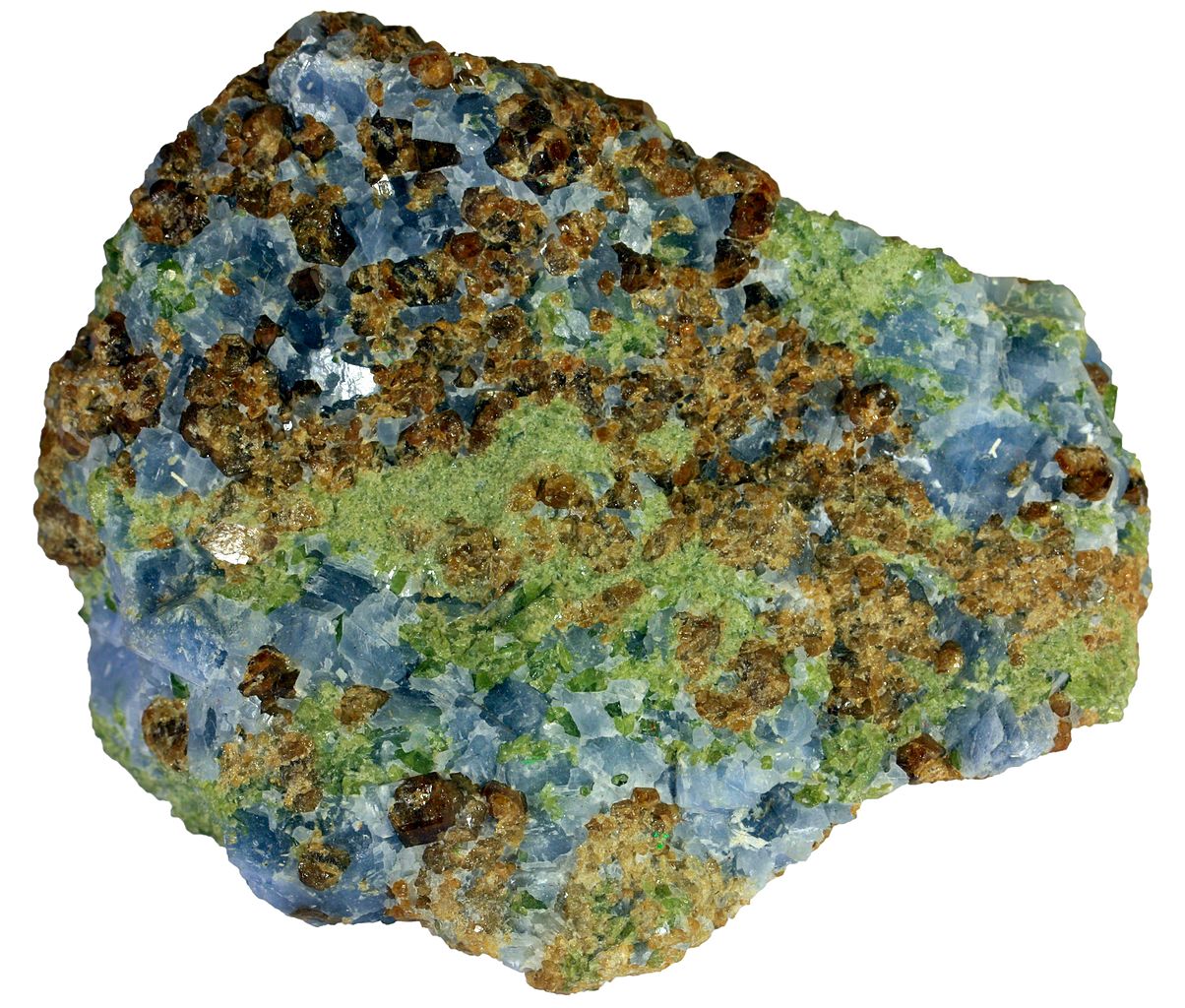
Hydrothermal metamorphism creates many different products. It can, for example, produce ore deposits by concentrating ore minerals (most commonly copper, iron, or lead sulfides) in host rocks where they did not exist previously. Hydrothermal metamorphism also may create skarns, a type of high-temperature contact metamorphic rock that develops when a great deal of metasomatism occurs. Figure 9.26, for example, is a photo of a skarn formed by metamorphism of a siliceous dolomite. The rock contains recrystallized blue calcite, red-grown garnet, and green pyroxene.
9.5.6 Impact Metamorphism
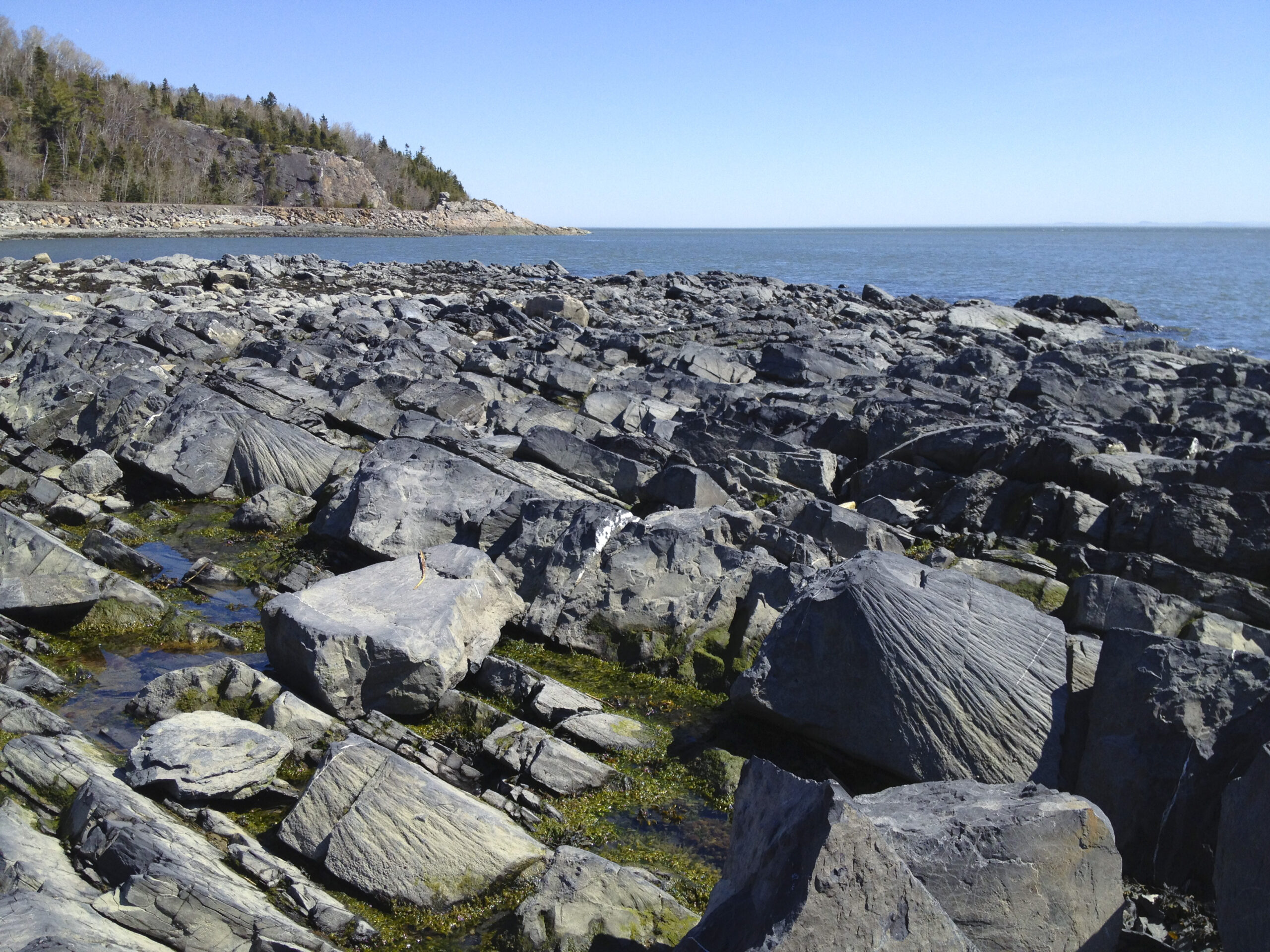
Impact metamorphism, also called shock metamorphism, occurs when a meteorite or other extraterrestrial body impacts Earth. The effects include rock shattering, mineral grain deformation, the formation of high-pressure minerals such as coesite and stishovite, and sometimes melting or vaporization of crustal rocks. Figure 9.27 is a photo of shatter cones created by a meteorite impact in Quebec. Shatter cones are akin to the damage that a pebble does when it strikes the windshield of your car.
9.6 Paths of Metamorphism
9.6.1 Prograde and Retrograde Metamorphism
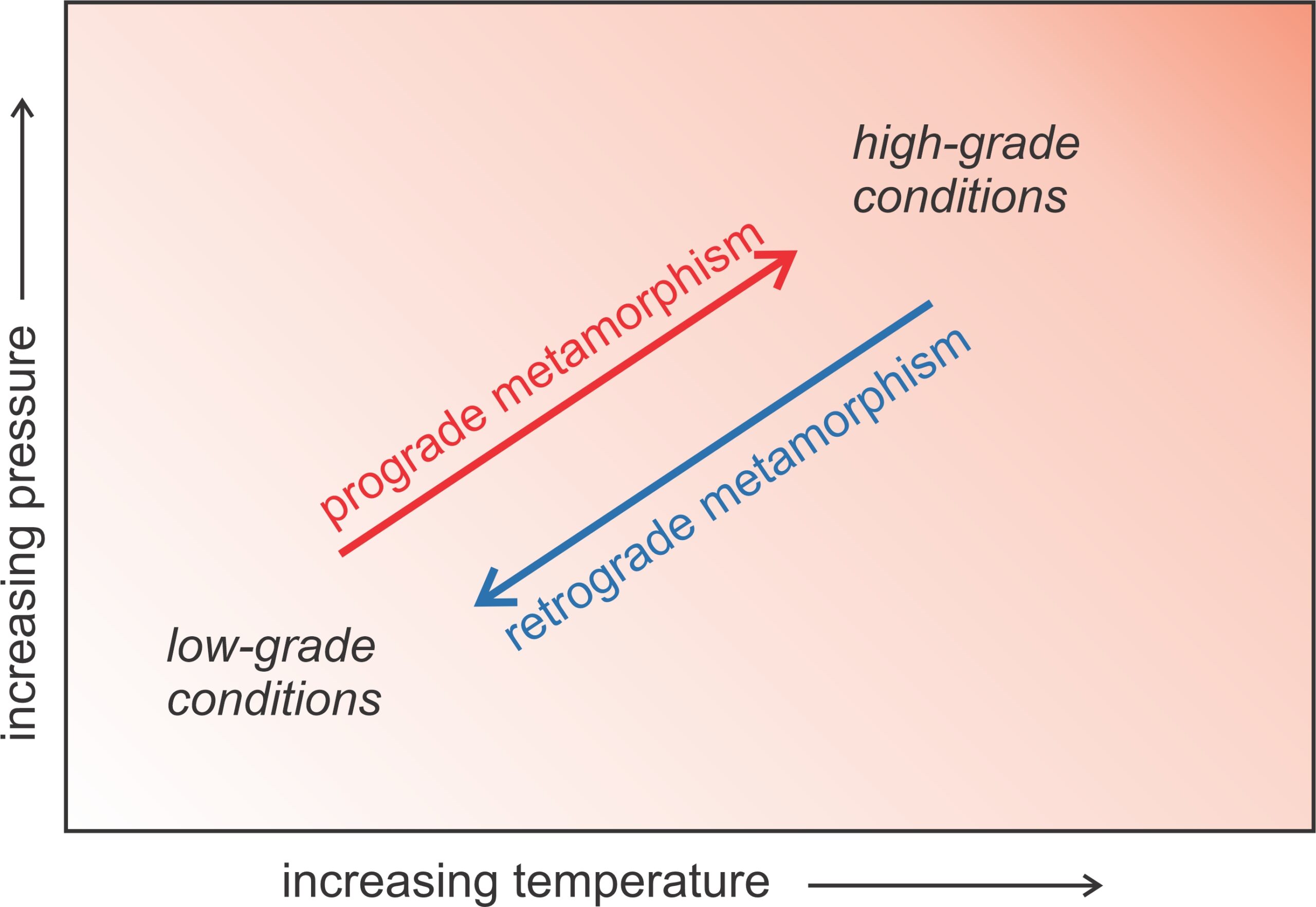
Figure 9.28 compares paths of prograde and retrograde regional metamorphism. Prograde metamorphism occurs when low-grade or unmetamorphosed rocks change mineralogy or texture in response to a temperature increase. This occurs, for example, during burial and heating associated with regional metamorphism. Regional prograde metamorphism involves both increasing temperature and pressure; contact metamorphism usually does not. Retrograde metamorphism is the opposite – it occurs when high-temperature metamorphic rocks or minerals reequilibrate at lower temperatures. Often this occurs during uplift (which lowers pressure) and cooling (which lowers temperature) associated with tectonism.
Most metamorphic rocks that we see are products of prograde metamorphism. During prograde metamorphism, rocks equilibrate at elevated temperature, and generally elevated pressure. Commonly, the rocks retain high-temperature minerals and fabrics after they cool and pressure decreases. Sometimes, however, retrogression occurs during cooling, or even after a rock has completely cooled, when the high-temperature minerals become metastable. Retrogression is especially likely when water is present leading to the formation of low-grade hydrous minerals such as chlorite, talc, or serpentine.
Retrograde reactions may change rock mineralogy or texture, or both. The amount of retrogression may be minor or quite significant. Some rocks contain both prograde and retrograde features, making interpretation problematic. Yet, we can often identify retrograde reactions and minerals. For example, original high-temperature minerals may exist in grain centers and be mantled by rims of lower-temperature minerals that formed during retrogression.
|
|
The rock seen in Figure 9.29 is an amphibolite that contains prograde garnets (red). Most of the rock is black hornblende and whitish plagioclase. Figure 9.30 also shows a garnet, or what was once a garnet, but it completely reacted to green chlorite during retrogression. We call this kind of replacement – when an original crystal maintains its shape but is now completely made of a replacement mineral – a pseudomorph.
Basalts and other high-temperature volcanic rocks initially equilibrate at high (solidus) temperature when they form. If subsequently metamorphosed at low-grade, the original high-temperature minerals will be replaced by low-temperature minerals. For example, the serpentinites seen in Figures 9.24 and 9.25 formed at low temperatures – but the protoliths were high-temperature basalts. So, low-grade metamorphism of igneous rocks is, in some ways, akin to retrograde metamorphism. But, by definition, retrograde metamorphism involves reequilibration of originally high-grade metamorphic rocks. It is different from low-temperature metamorphism of igneous rocks.
9.6.2 Progressive Metamorphism
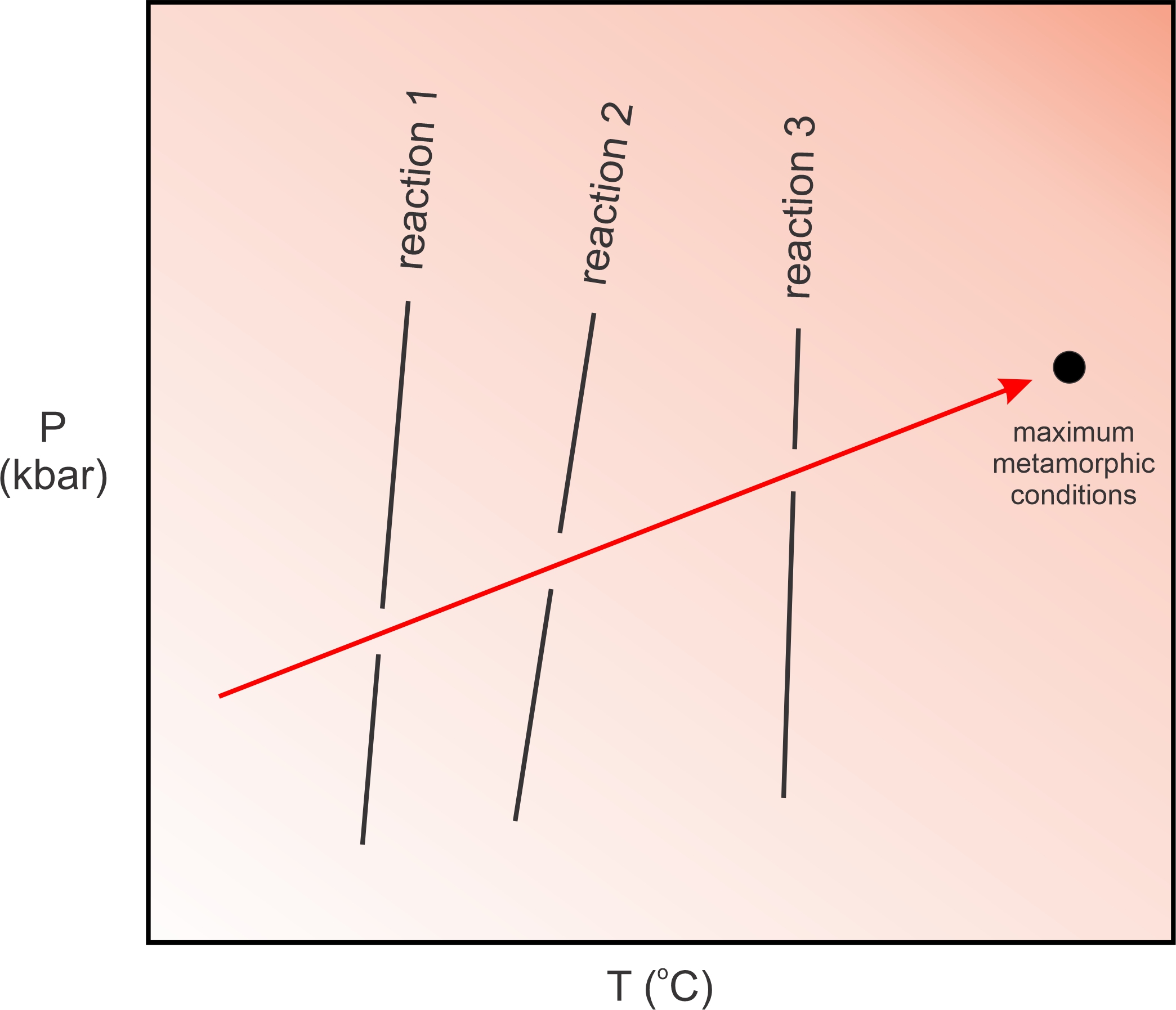
If the metamorphism is gradual and predictable, with one mineral assemblage giving way to another as metamorphism occurs, we call it progressive metamorphism. During progressive metamorphism, reactions occur sequentially as temperature rises and the degree of metamorphism increases (Figure 9.31). Rock mineralogy and texture, and mineral compositions, change in steps, or sometimes continuously, before reaching stable equilibrium at high-temperature conditions. Sometimes we find metastable relics of lower-grade minerals in a high-grade rock, testifying to the progressive nature of the metamorphism that occurred. We never, however, find evidence of an entire progressive metamorphic path.
While the idea of progressive metamorphism makes a convenient conceptual model, it may not be correct for all metamorphic rocks. For example, many metamorphic rocks formed deep in Earth where pressure and temperature are great. They were never unmetamorphosed rocks at low pressure and temperature and so never experienced progressive metamorphism. Other rocks go from low temperature to high temperature (perhaps because of rapid intrusion of a pluton that causes contact metamorphism) so quickly that they probably skip intermediate stages. Still other rocks may only partially equilibrate as temperature increases. Nonetheless, progressive metamorphism works as a good model in most cases.
9.6.3 P-T-t Paths
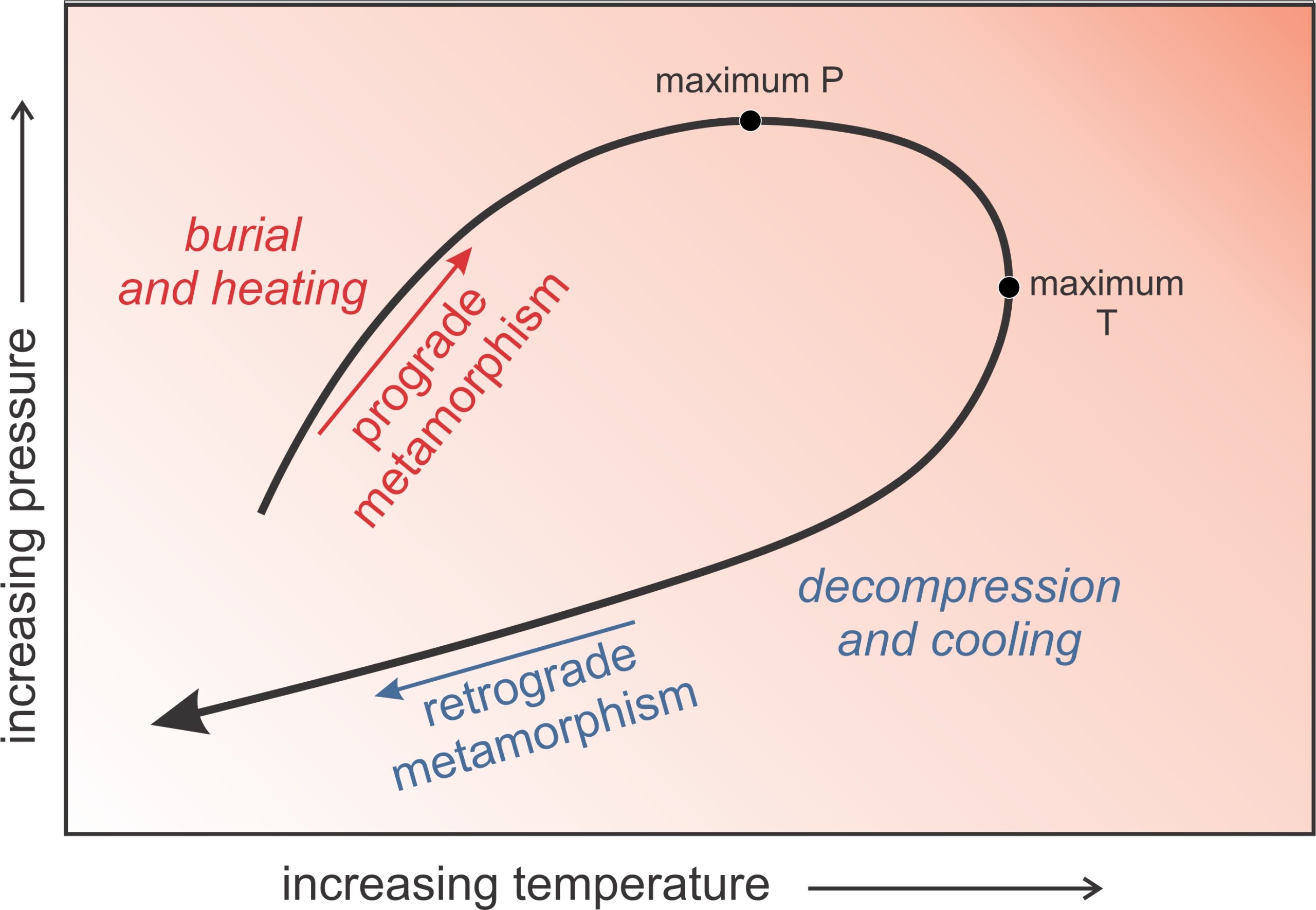
Figure 9.28 is a simple diagram suggesting that P-T paths followed during retrograde metamorphism are just the opposite of those followed during prograde metamorphism. During the past several decades, petrologists have found that this is often not so. Figure 9.32 shows a common kind of P-T-t path (pressure-temperature-time path) followed during regional metamorphism. Burial and heating caused prograde metamorphism, but burial occurred faster than heating, so the maximum pressure and temperature conditions were at different times. After the peak of metamorphism, uplift and decompression were more rapid than cooling. So, overall, the metamorphism follows what petrologists call a clockwise P-T-t path. A standard assumption, which seems to be correct in most instances, is that mineral assemblages in metamorphic rocks reflect the conditions of maximum temperature that the rock experienced. This, in large part, is because reaction rates (prograde and retrograde) increase exponentially with temperature, so the highest temperature assemblages are most likely to develop and persist during cooling.
Figure 9.32 is only one example of a possible P-T-t path. Many metamorphic rocks have been shown to follow different paths. Using various isotope dating systems, petrologists have sometimes been able to determine how long it takes a rock to complete a P-T-t path like the one seen in Figure 9.32. The times are highly variable depending on tectonic settings and rock type, but typically are on the order of 100 million years. anchor
9.6.4 Metamorphic Field Gradients

Mineral assemblages and metamorphic grade often vary across a regional metamorphic terrane. Consider, for instance, a hypothetical terrane where mineral assemblages are different in metapelites (metamorphosed shales) of the western, central, and eastern regions. All the metapelites contain muscovite and quartz, but andalusite, chloritoid and chlorite are also present in the western region. Garnet, staurolite, sillimanite, and chlorite are present in the central region, and garnet, biotite, and sillimanite are in rocks of the eastern region. As we will see in Chapter 14, the assemblages tell us that the rocks equilibrated in the general P-T ranges shown in blue in Figure 9.33.
We can draw an arrow (red in Figure 9.33) through the metamorphic conditions to get a metamorphic field gradient. Field gradients show the range of metamorphic conditions recorded by rocks across a terrane (in the field). A field gradient is not the same as a geothermal gradient, however, because the different metamorphic conditions were reached at different times in different places. Additionally the rocks in the different regions may have followed different P-T-t paths. Thus, field gradients reflect many things, including maximum metamorphic conditions, P-T-t paths, and the amount of uplift and exhumation that exposed the rocks.
9.7 The Role of the Protolith
Metamorphic rocks may contain all the minerals common in sedimentary and igneous rocks, plus many minerals exclusive to metamorphic rocks. The two most important factors controlling mineralogy are the composition of the rock and the pressure-temperature conditions of metamorphism. During metamorphism, most rocks change little in composition. The exceptions, when substantial metasomatism occurs, are relatively rare. So, for convenience, we divide the most common rock types into general compositional classes. Table 9.1 lists the most important classes considered by petrologists.
| Table 9.1. Some Different Kinds of Metamorphic Rocks and Their Protoliths | |
| rock class | protolith |
| metapelites | shale and related sediments |
| metasandstones | sandstones |
| metacarbonates | limestone or dolostone |
| metamorphosed iron formations | iron-rich sediments |
| metabasites | basaltic rocks |
| metgranites | granitic rocks or arkosic sandstone |
| metamorphosed peridotites | ultramafic rocks |
The composition of a metamorphic rock, which is the composition of the protolith, is the most important key controlling the metamorphic minerals that may be present. Metamorphic minerals in metapelites, metacarbonates, metabasites, metagranites, etc., are all different because of major differences in rock chemistry. Metapelites typically contain micas and may also contain staurolite, garnet, and other aluminous minerals. Besides containing calcite or dolomite, metacarbonates may contain Ca-Mg silicates. Metabasites may contain pyroxenes and amphiboles. And, metagranites usually contain the minerals that unmetamorphosed granites contain. In later chapters, we look at the minerals common in some rocks of different compositions. We focus mostly on prograde minerals, but rocks of any composition may undergo retrograde metamorphism or alteration that produce a variety of low-temperature minerals.
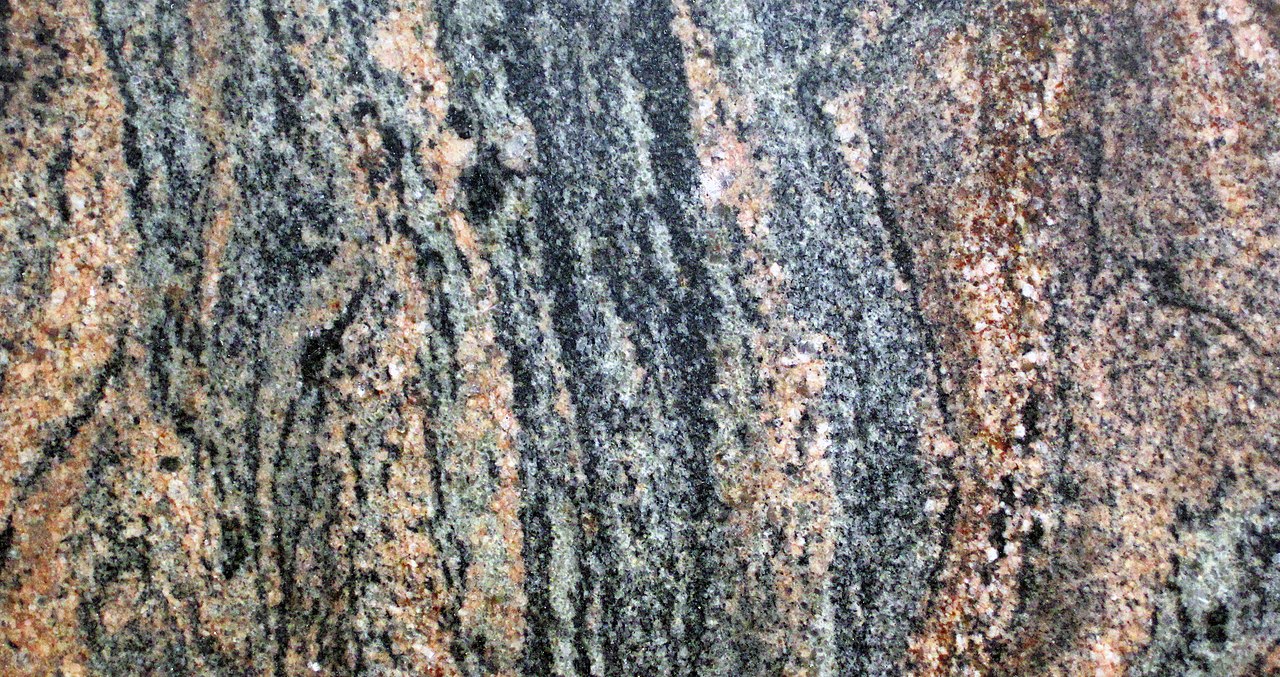
Some kinds of rocks change greatly when metamorphosed; others do not. Granite, for example, undergoes few mineralogical changes during metamorphism. Granites are mostly quartz and K-feldspar, and these two minerals are stable at just about all metamorphic conditions. However, if a granite contains mica (muscovite or biotite), or hornblende as accessory minerals, some new metamorphic minerals can form. The new minerals, however, will always be present in small amounts. Consequently, the biggest changes that occur when granite is metamorphosed are textural. Thus, granites may evolve to become gneisses if feldspar and quartz concentrate in different layers. And, with increasing metamorphism, the overall grain size of all minerals may increase. Figure 9.35 is a photo of a granite gneiss from the Minnesota River Valley. The large amount of pink K-feldspar and quartz in the rock suggest it was a granite before metamorphism.
Like granite, sandstones made only of quartz, and limestones made only of calcite or dolomite, may recrystallize during metamorphism as they become quartzite or marble, but no new metamorphic minerals can form. Yet, if the sandstone contains some clay, or the limestone contains some quartz or clay, new metamorphic minerals can form. Thus, the mineralogical composition of the protolith is very important.
In contrast with granites, shales (pelitic rocks) change greatly during metamorphism. The primary minerals in shales have limited stability fields and react to produce a series of different metamorphic minerals that vary with metamorphic conditions. For example, Figure 9.36 shows a 13-cm wide sample of kyanite schist from Glen Clova, between Edinbugh and Aberdeen, Scotland. Quartz and red garnet accompany the blue kyanite. And Figure 9.37 is a photo of a 15-cm wide rock containing brown staurolite crystals in a fine-grained matrix that is mostly muscovite. Both kyanite and staurolite are very aluminous, and shale is the only composition protolith that could react to create these rocks. Metapelites also develop different metamorphic fabrics depending on the degree of metamorphism.
Other composition protliths develop various and distinctive metamorphic minerals. Metamorphosed basalts may contain chlorite, actinolite, epidote, hornblende, and pyroxene. Low-grade metamorphosed ultramafic rocks often contain new hydrous minerals (including brucite, talc, and serpentine discussed earlier in this chapter) and new textures when metamorphosed. Iron formations, too, undergo significant changes during metamorphism because several different iron oxides, amphiboles, pyroxenes, and olivine will form depending on metamorphic conditions. And metamorphosed carbonates may contain any of a dozen different minerals, provided the protolith contained some quartz or clay.
Sometimes we want to avoid jargon, and sometimes metamorphic rocks do not fit easily into any of the categories listed in Table 9.1. If the protolith is obvious, however, we may simplify by adding the prefix meta to the protolith names. So, a metabasalt is a metamorphosed basalt, a metagranite is a metamorphosed granite, a metasandstone is a metamorphosed sandstone, and a metaconglomerate is a metamorphosed conglomerate.
The discussions of regional metamorphism later in this book focuses mostly on pelites and mafic rocks, and the discussion of contact metamorphism focuses on pelites and carbonates. But pelites, mafic rocks, and carbonates are only examples. The principles introduced apply equally to all compositions.
● Figure CreditsUncredited graphics/photos came from the authors and other primary contributors to this book. 9.0 (opening photo) Kyanite schist, Ethan Baxter, Twitter |
Contents
- 9.1 What Is Metamorphism?
- 9.2 Conditions of Metamorphism
- ● Box 9.1 Extremes of Metamorphism
- 9.3 The Distinctions Between Sedimentary, Metamorphic, and Igneous Processes
- 9.4 Agents of Metamorphism
- 9.5 Different Kinds of Metamorphism
- 9.6 Paths of Metamorphism
- ● Box 9.2 Why do we have any high-grade rocks to study?
- 9.7 The Role of the Protolith
- ● Figure Credits
